Abstract
In this paper, the accuracy of an in-house Actuator Line (AL) model is tested on aeroelastic simulations of a Wind Turbine (WT) rotor and a helicopter Main Rotor (MR) under uniform free-stream flow. For the scope of aeroelastic analyses, the AL model is coupled with an in-house multibody dynamics code in which the blades are modeled as beams. The advantage from the introduction of CFD analysis in rotorcraft aeroelasticity is related to its capability to account in detail for the interaction of the rotor wake with the boundary layer developed on the surrounding bodies. This has proven to be of great importance in order to accurately estimate the aerodynamic forces and thus the corresponding structural loads and deflections of the blades. In wind turbine applications, a good example of the above is the rotor/ground interaction. In helicopter configurations, the interaction of MR with the ground or the fuselage and the interaction of tail rotor with the duct in fenestron configurations are typical examples. Furthermore, CFD aerodynamic analysis is an obvious modeling option in which the above mentioned asset can be combined with the consideration of the mutual interaction of the rotor with the ambient turbulence. A WT rotor operating inside the atmospheric boundary layer under turbulent free-stream flow is such a case. In the paper, AL results are compared against Blade Element Momentum (BEM) and Lifting Line (LL) model results in the case of the WT, whereas LL and measured data are considered in the helicopter cases. Blade loads and deflections are mainly compared as azimuthal variations. In the helicopter MR cases, where comparison is made against experimental data, harmonic analysis of structural loads is shown as well. Overall, AL proves to be as reliable as LL in the canonical cases addressed in this paper in terms of loads and deflections predictions. Therefore, it can be trusted in more complex flow conditions where viscous effects are pronounced.
1. Introduction
The Actuator Line (AL) method [1] is a renowned CFD technique widely used in the aerodynamic analysis of Wind Turbine (WT) rotors. In particular, it has been employed in studying the generation and convection of rotor wakes [2,3]. There are also publications where it has been used in helicopter rotor aerodynamic analyses [4,5,6], particularly when costly simulations are involved, in which a detailed distribution of the blade loading is not an absolute requirement. The broad application of AL stems from the high fidelity level that the CFD context provides, alongside with the limited computational requirements of the methodology. The latter originates in the fact that the rotor blades are not fully resolved, rather than modeled as a set of blade elements along their axis. Just by a simple blade element analysis, together with the use of predefined airfoil polars, the blade forces can be calculated in a cost effective manner and then applied to the flow as source terms of the Navier–Stokes equations. In this way, the effect of the rotor on the flow can be accounted for in great detail [7,8].
Incorporating CFD in rotor analysis renders feasible the estimation of viscous and turbulence effects. These are significant in wind farm simulations, where rotor wake diffusion has an impact on the performance of the downwind turbines. Furthermore, viscous effects are important when studying the rotor wake interaction with the boundary layer developed on surrounding bodies (e.g., helicopter obstacle [9] or WT tower) or even the ground. Such interactions affect the rotor performance and the loading of the rotor [10,11]. Another possible aspect where CFD analysis may be needed is the rotor operation close to bluff bodies with a non-thin boundary layer. Separation of flow around the fuselage is known to induce vibrations on blade loads. Hence, resolving the vortex shedding from bluff bodies in the operating region of rotors is of great importance.
The main shortcoming of the method is that numerous numerical parameters are involved that affect load predictions. In particular, the method used in the projection of the blade forces onto the CFD grid plays an important role in the intensity of the produced tip and root vortices [12]. As a result, in order to capture the blade loads in detail, a case specific tuning is needed for these parameters. A great deal of research effort has been devoted to determining the best practices of body force projection [13,14,15,16]. A common requirement for the successful application of all these methods is the adoption of really fine grid resolution around the blades and in particular close to the blades tip. The alternative is to use a coarse mesh and account for the tip vortex effect through proper tip loss correction models [17,18]. In most of the above cited studies, AL results are compared against results produced by a Lifting Line (LL) model [19] or a Blade Element Momentum (BEM) model that uses Prandtl’s tip correction [20]. Nevertheless, capturing blade loads in detail is still considered to be an issue under investigation for AL methodologies, which requires further development.
As a result, aeroelastic simulations using AL have been published only by few researchers, mainly in the fields of WTs. In [8], the AL methodology implemented in EllipSys3D is loosely coupled with the aeroelastic code Flex5, where the structural analysis is performed in the context of modal reduction. The study focuses on wake characteristics investigation under turbulent free-stream flow. Moreover, a comparison against experimental measurements is performed regarding aerodynamic performance characteristics (power production and rotor thrust loading for various wind speeds) on a model scale turbine. In [21], an OpenFOAM implementation of the AL method described in [22] is tightly coupled with an in-house structural solver, which is again based on modal analysis. The publication provides detailed description of the coupling procedure and the validity of this new aeroelastic tool is checked through a comparison of blade loads at specific spanwise positions, power generation, and blade tip deflection against the respective results of rigid blades. The benchmark comparisons are confined to simple axial flow cases of the NREL 5 MW reference wind turbine [23]. In [24], a standard AL implementation on an incompressible RANS solver is two-way coupled with a finite differences discretization of the 1st order Euler–Bernouli beam model. Root flapwise moment and tip deflection on axial flow cases of the NREL 5MW are compared against standard BEM results obtained using FAST [25]. Furthermore, fatigue analysis is performed for two-staggered rotors that operate inside the atmospheric boundary layer. In [26], an OpenFOAM implementation of AL is coupled with a simplified 1st order representation of the rotating beam dynamic equations. Performance analysis results and blade tip displacements on axial flow cases of NREL 5 MW are compared against NREL reference data (extracted using FAST) and results by other researchers. Recently, in [27], a larger scale WT rotor (DTU 10 MW reference wind turbine [28]) was used as a test model of a loose coupling between EllipSys3D and Flex5. Steady-state performance and damage equivalent loads of the elastic AL model are compared against those obtained by an Actuator Disk (AD) model and the standard BEM model. As far as helicopter rotors are concerned, the AL developments found in the literature focus on pure aerodynamic analysis. At least to the author’s knowledge, no publications have dealt with aeroelastic simulations of helicopter rotors by applying AL as the aerodynamic tool.
In the present work, an AL aerodynamic model is integrated within a multi body structural dynamics environment for the unified treatment of rotorcraft applications exceeding the context of wind energy applications. Most of the previous aeroelastic developments using AL aerodynamic options, are based on simplified structural dynamic models or linear modal representations. The herein proposed model employs high level of fidelity also in the modeling of the structural dynamics. The multibody model used considers flexible components as non-linearly inter-connected beams (application of nonlinear constraint equations) which are numerically treated in the context of FEM analysis. The above model accounts for non-linear geometric and inertial effects due to large deflections while they can incorporate in the analysis the full structure of the simulated configuration (e.g., wind turbine tower or rotor pylon and other flexible elements of the hub and control chain). The objective of this paper is to assess the accuracy of the AL aerodynamic model in strong coupling with the above described structural dynamics module, by comparing its results with lower fidelity aerodynamic models or experimental data. Two different rotorcraft application examples are considered: (a) WT rotor and (b) Helicopter MR. In order to assess the effect of various numerical parameters on loads prediction, any engineering correction model that needs case specific tuning (e.g., tip correction models) is neglected and the numerical parameters that affect the produced results in a more generic way are investigated in detail. A new way to define the projection width of the calculated aerodynamic forces is proposed, which leads to a straightforward grid independent solution.
The test cases considered in the WT analyses extend from simple axial to asymmetric, yaw misaligned flow conditions. Existing literature on AL aeroelastic analyses solely deals with axial flow conditions while yaw misaligned flows are neglected. Recent developments in wind farm control propose wake deflection strategies [29] as an effective approach for increasing power performance and reducing loads. The aforementioned wake control techniques are also popular in floating offshore wind turbine applications [30] in which complex wind turbine dynamics and wave induced motions cannot be accounted for by simplified structural dynamic modules. Therefore, coupling aerodynamic options capable of resolving multi-rotor wake interactions in high fidelity structural dynamic modules that accommodate complicated system dynamics and non-linear flexibilities is considered essential. Furthermore, simulating asymmetric yawed flow conditions is directly linked to helicopter aerodynamics. This is the second application example addressed in the present work.
More specifically, in the WT cases, the rotor of the conceptual DTU 10 MW reference wind turbine [28] is modeled. Uniform free-stream flow conditions are simulated for wind speeds of 8 and 11 m/s. Yaw misalignment conditions are considered as well, where free-stream flow angle ranges from −30 to +30. Constant rotational speed and blade pitch angle is assumed for all WT cases. Blade loads and elastic displacements results are depicted as azimuthal variations and radial distributions along the blade span. Comparisons are made between a standard BEM model and the classical LL approach under the framework of free vortex wake modeling [31]. WT analyses are usually based on BEM models, as they are fast and reliable in simple flow cases. Therefore, they have been widely employed in design and analysis. For this reason, BEM results are regarded as reference data in WT simulations of this work. When analyzing complex aerodynamic conditions (yaw misalignment or high shear of the atmospheric boundary layer), the LL model consists of a more accurate alternative due to the detailed vortex particle representation of the wake and the inclusion of viscous corrections on blade loads through dynamic stall models. Consequently, LL results will be used as an extra reference in complex free-stream flow conditions, where AL and BEM results are expected to deviate.
As for the helicopter simulations, a scaled model of BO105 MR is simulated, for which wind tunnel measurements of loads and deflections are available. In this case, AL and LL predictions will be compared against HeliNOVI wind tunnel measured data [32]. Only forward flight conditions are tested at low (12.3 m/s), medium (50.5 & 50.9 m/s), and high (69.6 & 69.9 m/s) flight conditions. Azimuthal variation of loads and deflections and load harmonics (in terms of amplitude and phase) are compared to measured data.
All the AL simulations performed in this work consider inviscid flow. The reason for that is that BEM and LL are inherently inviscid. In this way, a fair comparison can be made between the different aerodynamic models. Even for the Helicopter MR simulations, where measured data have been used as reference, viscosity is not expected to have any significant effect on the results. This is justified by the fact that the experiments have been conducted in a wind tunnel, without the introduction of any turbulence intensity in the free-stream flow.
2. Methodology
In-house computational tools are used both for the aerodynamic flow analysis and the structural dynamic analysis.
2.1. The Aerodynamic Model
Concerning aerodynamics, MaPFlow [33,34,35] is used, which solves the compressible Unsteady Reynolds Averaged Navier–Stokes (URANS) equations under a cell-centered finite volume spatial discretization scheme. MaPFlow can handle both structured and unstructured grids, it is parallelized under the MPI protocol, and the grid partitioning is performed using the METIS library [36]. The convective fluxes are evaluated by solving the preconditioned local Riemann problem between the neighboring cells of each face, using the Roe’s approximate Riemann solver [37] with the Venkatakrishnan limiter [38]. The viscous fluxes are discretized using a central 2nd order scheme. For the reconstruction of variables at the interface a piecewise linear interpolation scheme is used. The evaluation of the spatial gradients of the primitive variables is done using the Green–Gauss formula, with a centered scheme approximation. Multiple options are available for turbulence modeling, such as the one-equation model of Spalart–Allmaras [39] or the two-equation model k-w SST of Menter [40]. Regarding laminar to turbulent flow transition modeling, the γ-Reθ model of Menter [41] is used. A Delayed Detached Eddy Simulation (DDES) approach is also implemented in MaPFlow, following the suggestions of [42]. Unsteady simulations are performed through an implicit second order backwards difference scheme [43], along with a dual time-stepping technique [44] in order to facilitate convergence. Finally, the implicit operator inversion is accomplished with the use of the Gauss–Seidel iterative method alongside with the Reverse Cuthill–Mckee reordering scheme.
In the AL methodology implemented within MaPFlow, the blade loads are calculated on specific control points along the blade span through a blade element analysis. The control points aerodynamic forces are then applied to the flow as source terms of the flow equations. In order to avoid numerical instabilities, these source terms are smeared across the cells surrounding the rotating blades through a Gaussian convolution:
where:
- is the projected force per unit volume [N/m];
- is the calculated force on the actuator line emission (control) point [N];
- r is the distance between the actuator line emission point and the point where the force is applied [m];
- is the Gaussian kernel that defines the projection width [m].
There are numerous advantages when following this approach:
- CFD mesh is not forced to follow the blades rotation;
- Overset grids methodologies can be avoided when interaction between rotor wake and other configurations (e.g., WT tower, helicopter fuselage, other rotors) is to be assessed;
- Aeroelastic simulations can be performed without many implementation difficulties, as the the computational grid is not burdened to deform along with the blades.
The above render the AL model befitting for complex aeroelastic analyses, provided that the loads are accurately predicted. The main weakness of AL is its dependence on tabulated airfoil data. The correct estimation of aerodynamic loads in stall conditions is critical in aeroelastic simulations when the aerodynamic options are based on 2D polars. For this reason, a dynamic stall model needs to be used. In simulations of this research, the extended ONERA model [45] has been used. The delay parameter of the original ONERA model, which accounts for dynamic stall delay in deep dynamic stall conditions is omitted. Moreover, the leading edge vortex and the vortex shedding effect considered by Truong [46] in more recent versions of the ONERA model are not included in the present implementation. These are not expected to have a significant effect on predicted aerodynamic and structural loads as the DTU 10MW turbine is a pitch regulated one while in BO105 simulations only forward flight cases are addressed. Consequently, all the simulation cases considered deal with light stall conditions, a maximum effective angle of attack lies in the vicinity of where the leading edge vortex is not present. Analytical description and implementation details of the Dynamic Stall model utilized in the aeroelastic cases addressed in this work can be found in [47]. Nevertheless, polars, even though corrected for unsteady aerodynamics and dynamic stall effects, still cannot account for unsteady phenomena due to vortex shedding (e.g., when massive flow separation takes place or secondary cross-flow effects at the scale of chord length).
2.2. The Structural Dynamics Model
In order to account for the blades structural and dynamic response, hGAST [48,49,50,51] is used. hGAST is a servo-elasto-dynamic solver based on a multi-body approach, where all flexible components are modeled as flexible full stiffness matrix [52] Timoshenko beams. Numerical discretization is applied through FEM approximation. In this way, apart from the blades, the flexible elements of the control chain of a helicopter main rotor (blade hub, pitch link, horn, etc.) or a wind turbine configuration (shaft, tower) may be included. Rigid body and elastic motion due to structural flexibility are concurrently accounted for within the multibody dynamics framework, alongside the non-linear inertial and structural effects and geometric couplings imposed by large deflections of highly flexible components (e.g., blades). These highly flexible components are approximated as an assembly of linear Timoshenko beam structures (sub-bodies). The interconnected linear sub-bodies are linked to each other through proper non-linear kinematic and dynamic compatibility equations. In this way, non-linear geometric and aeroelastic effects due to high deformation are accounted for using linear beam theory at the sub-body level, but considering non-linear effects at the connection points [51]. Following this approach, multiple load path joints can be introduced. Briefly, at the connection points between different sub-bodies, one of them provides the kinematic condition (position/velocity and orientation/angular velocity) to the others, while the rest have to contribute their reaction loads (see Figure 1).
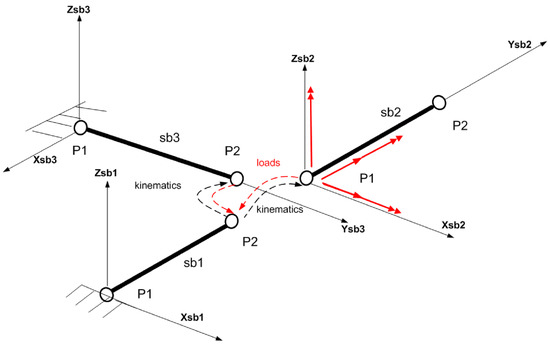
Figure 1.
Compatibility conditions. Example between 3 sub-bodies (sb1, sb2, sb3).
A local coordinate system is attached to the start point (P1) of every sub-body. Local elastic deformations resulting from the beam dynamic equations are defined with respect to this system. This local frame of every sub-body k is subjected to 3 translations and 3 rotations , which include rigid body motion undergone by the sub-body and elastic motions induced by other sub-bodies connected to them. For the th body, let denote a set of (rigid body) displacements and rotations (time variant or invariant) that define the origin and orientation of the local system of the th body in the undeflected state. Rigid body translations will place the component at , while rigid body rotations lead to its rotation matrix . Based on the above, the (global) position vector of any arbitrary point P over the deflected th body with respect to the global inertial frame is expressed through the (local) position vector of P in the undeflected state and the vector of the local elastic deflections (displacements and rotations) (both defined in sub-body local co-ordinates) and the rigid body motion as follows:
where matrix is given by:
Kinematic constraints are applied to the end nodes of connected components. For example, in Figure 2, the node of component r is rigidly connected to the node of component m. As a result, 3 translation and 3 rotation nonlinear constraint equations are defined, expressed through the following nonlinear position/orientation equations:
where is a column matrix that contains the relative rotation angles between the connected points defined in the local coordinate system of node of component m. The relative angles are given by [53]:
where are such that and , are the two unit vector bases defining the local frames of the connected nodes (see Figure 2). To conclude, the elasto-dynamic equations are linearized and expressed in perturbed form. Equivalent mass , damping , and stiffness matrices are computed. The linearized equations are solved iteratively using the 2nd order implicit Newmark method [54]. Modal analysis can be also performed on the calculated matrices around the defined reference state.
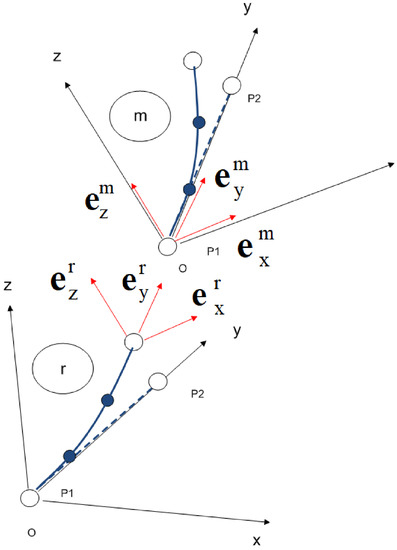
Figure 2.
Local bases vectors of interconnection points.
MaPFlow has been validated in pure aerodynamic analyses against experimental measurements and other computational tools [28]. The same holds for hGAST when coupled with BEM and vortex type aerodynamic models [28,55]. In the present work, the coupled hGAST/MaPFlow tool is validated. More details about the implementation of the under investigation AL module within MaPFlow and the aeroelastic coupling can be found in [55].
3. Actuator Line Numerical Analysis
In this section, a detailed overview of the employed numerical parameters is presented. In the AL methodology and the CFD context in general, there are plenty of numerical parameters that can affect the predicted loads. To minimize any uncertainties regarding the validity of the produced results, a thorough investigation of all numerical parameters is needed.
3.1. Wind Turbine Rotor Numerical Analysis
The AL numerical parameters regarding the WT simulations have been tested on an axial case at a 11-m/s uniform wind speed. The blades are evenly distributed and considered to be rigid. Structural deflections alongside prebend, cone, and tilt angle of the blades are neglected, so that the configuration is as simple as possible for this parametric study. As a result, we end up with a purely axisymmetric case. In order to reduce computational cost, only one blade has been resolved in the rotating frame, with the use of periodic boundaries and in steady-state condition. The domain is a cylindrical section of 20 rotor diameters () length (see Figure 3) and radius (see Figure 4). Structured and uniform meshing under maximum grid resolution is applied in a thin region surrounding the actuator line. The structured area extends adequately around the actuator line, so that maximum accuracy is acquired in resolving the Gaussian projection of loads (see Figure 5). The characteristic length of this region is denoted by . Moreover, an unstructured and slightly coarser region is considered in order to take into account the near wake impact on the aerodynamic forces. This area extends up to upstream, downstream, and radially from the actuator line, so that the wake expansion is regarded properly. The characteristic length of this region is denoted by .
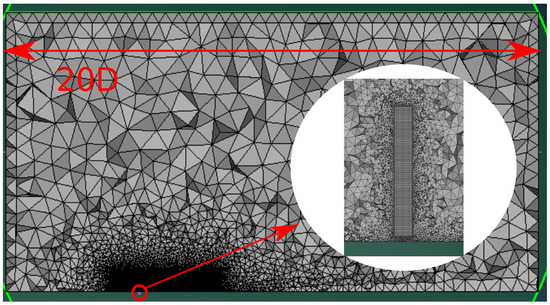
Figure 3.
Periodic grid. Lateral view.
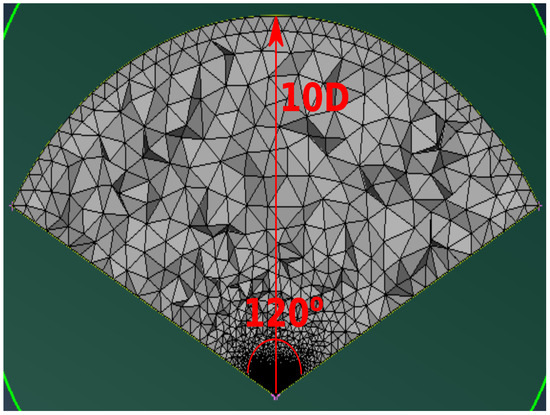
Figure 4.
Periodic grid. Axial view.
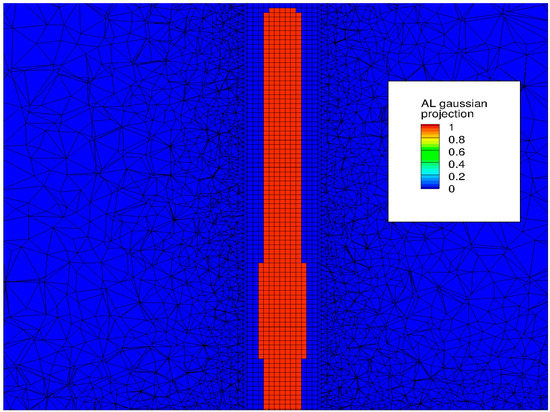
Figure 5.
Periodic grid. Gaussian projection of aerodynamic forces.
The first priority is to determine . The results from the analysis are presented in Figure 6 and Table 1. Each column lists the extracted power in MW, with respect to different values of and for various strategies to define the Gaussian kernel value . The standard approach in defining based solely on [3] fails to provide a grid independent solution. Since the blade geometry is not resolved, flow does not perceive the presence of a solid body. In order to perform a more accurate simulation that takes into account the blade geometry, the Gaussian distribution of loads is made using varying kernel . The value of is independent of the changes in the grid size and is proportional to the chord c of each blade section [13]. The proportionality factor is chosen so that the Gaussian projection of the aerodynamic forces extends only up to around the emission points. The projection width is . If the projection width is decided to extend up to around the emission points, then or . This approach can resolve in detail the blade geometry and thus allow very fine grid resolution in the AL vicinity. However, the reduction of the chord close to the tip results in very small values of , even less than , leading to numerical singularities. Therefore, a lower bound is set for , , as proposed by [3]. Based on the results in Table 1, seems to be a good trade-off between accuracy and computational cost.
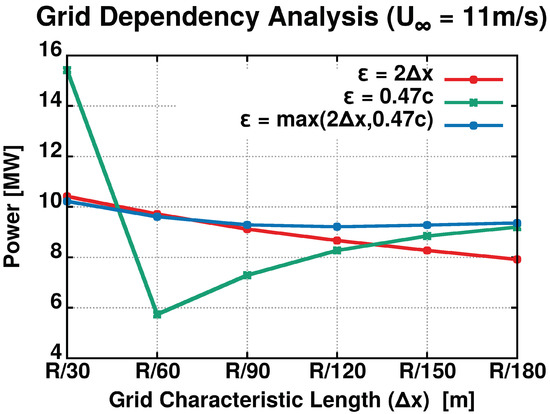
Figure 6.
Grid dependency analysis. Power [MW] vs grid characteristic length [m].

Table 1.
Variation of power [MW] with increasing the structured region characteristic length [m]. Reference power corresponds to minimum value .
The outcome of the investigation of the effect of the number of strips () (AL control points are located at the center of each strip) and their distribution pattern in the power output is shown in Table 2 and Figure 7 and Figure 8. As a first step, the AL control points are uniformly distributed along the blade, thus leading to a constant strip length (). The parameter is not independently studied, except through the correlation of with . In Table 2, it is clear that is a reasonable rule of thumb to define . Nevertheless, since adds no significant computational cost, the ratio will be used in the following WT aeroelastic simulations, in order to ensure a smooth representation of the radial distribution of aerodynamic forces. Figure 7 and Figure 8 present a comparison between a uniform distribution of control points () with a non-uniform one with the same number of points. Non-uniformity implies a coarse discretization close to the root that gradually gets finer as we approach the tip. As seen in Figure 7 and Figure 8, where the normal and tangential force along the blade span are plotted for the two different discretizations, the two distributions almost coincide due to the large number of points used. Uniform distribution better resolves the loads at the radius of ≈30 m where a local peak appears in particular in the tangential force. No advantage is observed at the tip region when employing denser distribution of points. It is easy to understand that due to the large number of control points along the blade span, a non-uniform distribution adds no extra benefit. Consequently, constant strip length is adopted for the sake of simplicity.

Table 2.
Variation of power [MW] with increasing blade grid size [m]. Reference power corresponds to minimum value .
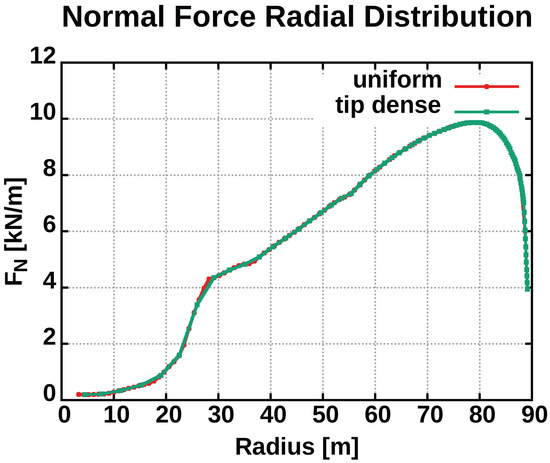
Figure 7.
Normal force radial distribution. Comparison of uniform and tip dense distribution of strips.
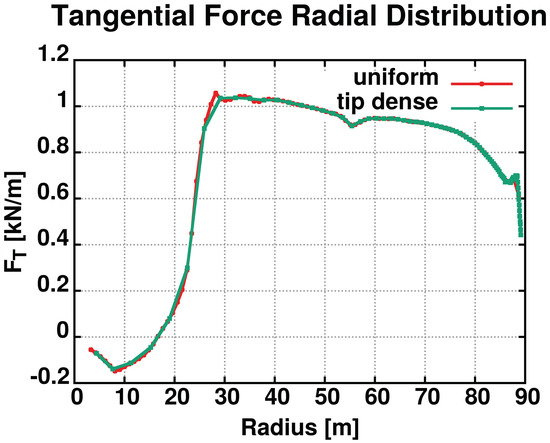
Figure 8.
Tangential force radial distribution. Comparison of uniform and tip dense distribution of strips.
Wake region characteristic length is examined in Table 3. The crucial aspect in choosing is the detail in resolving near wake velocity and vorticity. Apparently, as gets finer, the accuracy of predicted flow field is enhanced, which comes at an extra computational cost. This improvement does not imply any additional benefits in load predictions which is the main focus of the present work. For this reason is considered a good compromise between accuracy and computational cost. However, if wake dynamics is important (simulation of multiple aligned WT rotors, interacting with each other), should be refined as much as possible in order to reduce numerical diffusion in the wake.

Table 3.
Variation of power [MW] with increasing wake region characteristic length [m]. Reference power corresponds to minimum value .
Next, the time-step is investigated. In most AL implementations, is picked so that the blade tip will cross a maximum of one cell between two consecutive time-steps . However, based on the results in Table 4, a more strict approach of the above rule of thumb is required for WT simulations. Table 4 results have been extracted by a typical unsteady, 3-bladed rotor simulation on a full-scale grid like the one that will be used for the aeroelastic simulations that follow.

Table 4.
Variation of power [MW] with increasing time-step [sec]. Reference power corresponds to minimum value .
Another crucial aspect is the grid type employed. Fully unstructured, structured, and hybrid grids can be used. Structured grids are orthogonal but with high aspect ratio cells. On the other hand, unstructured grids result in a good aspect ratio, but orthogonality is lost. The projection method used in the AL approach can be sensitive to the type of grid. For this reason, mesh structure needs to be properly examined. In Figure 9, Figure 10 and Figure 11, four different grid setups are visualized, whereas in Table 5 the total number of grid cells and the power outcome of each setup are listed. In Figure 9 a fully structured grid (“setup1”) is shown with 8.9 million cells. The area nearby the rotor is kept uniform and fine with a characteristic length of , followed by a gradual coarsening up to at the limits of the near wake region and a steeper one up to the outer boundaries of the mesh. Figure 10 illustrates two meshing strategies similar to the one used in the periodic, steady-state simulations. Particularly, in “setup2” a fine and structured area is considered around the blade with length , while the rest of the domain is unstructured. Again the near wake region has a characteristic length of and the total amount of grid cells is 2.9 million. The only difference in “setup3” is that the AL vicinity is unstructured, thus exploding the number of cells to 6.2 million. Finally, a hexahedral mesh (“setup4”) is shown in Figure 11 with a total number of 1.9 million cells. The characteristic lengths of close to the rotor and in the near wake region have been maintained in this setup. Based on Table 5, all 4 mesh setups produce similar results. “setup3” shows the greatest discrepancy due to the reduced accuracy in the AL region provoked by the unstructured meshing. “setup4” was preferred due to its minimum number of grid cells.
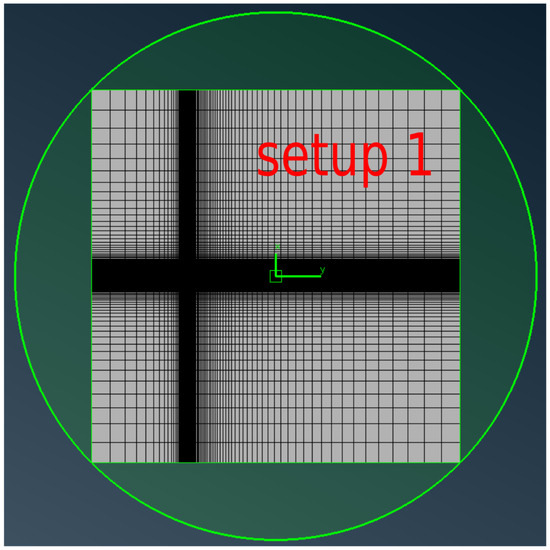
Figure 9.
Wind turbine fully structured grid setup.
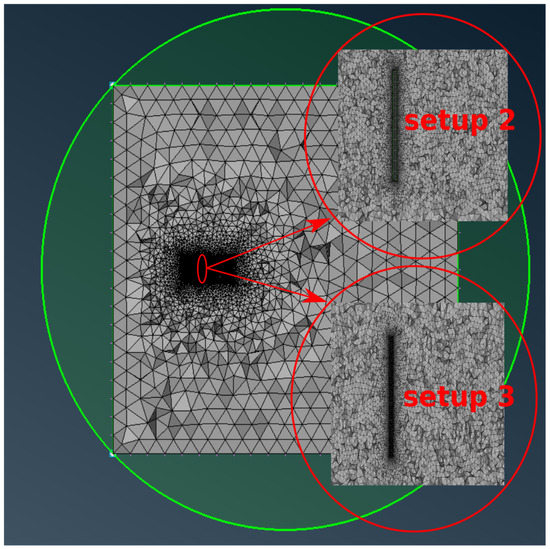
Figure 10.
Wind turbine unstructured grid setup.
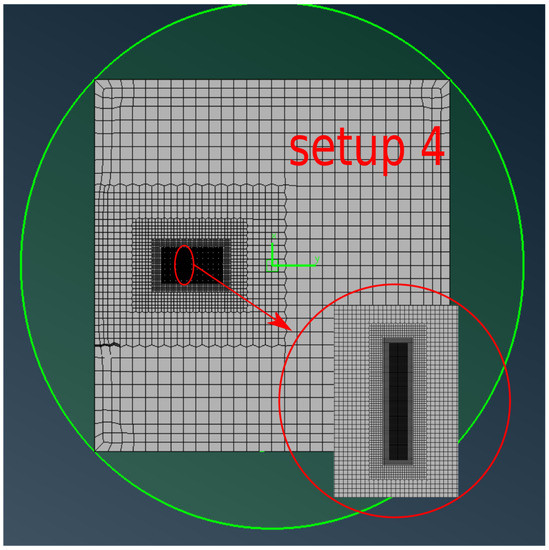
Figure 11.
Wind turbine hexa grid setup.

Table 5.
Variaton of power [MW] with different grid setup. Reference power corresponds to grid “setup4”.
In order to verify the choice of the aerodynamic numerical parameters in an aeroelastic context, coupled aeroelastic simulations are performed under axial wind speed at 8 and 11 m/s. In these cases the prebend, cone, and tilt angle of the blades are accounted for. It is revealed that by choosing , and higher artifact harmonic frequencies are excited. As a result, the signals of loads and deflections, except form the dominant variation are contaminated by significant higher harmonic frequency components. The variation is brought about by the 5 tilt angle of the rotor. As presented in Figure 12 and Figure 13, increasing has a damping effect on the artifact harmonics, since the AL sources get spread in a wider region. In this way, the amplitude of artifact harmonics becomes significantly decreased. The larger the wind speed, the greater the needed increase of , so we end up with at m/s and at 11 m/s. The induced increase in the mean value of the deflection is and respectively with respect to .
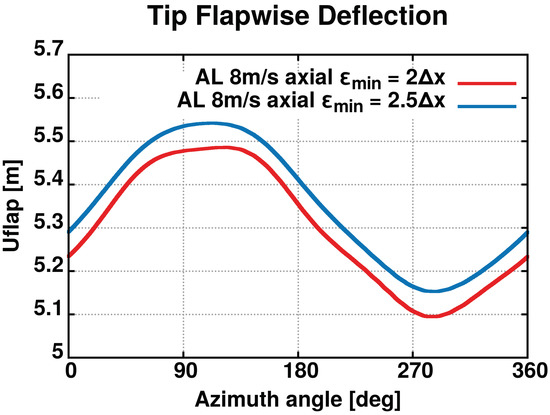
Figure 12.
Minimum value of investigation. Flapwise deflection in axial uniform free-stream flow at 8 m/s.
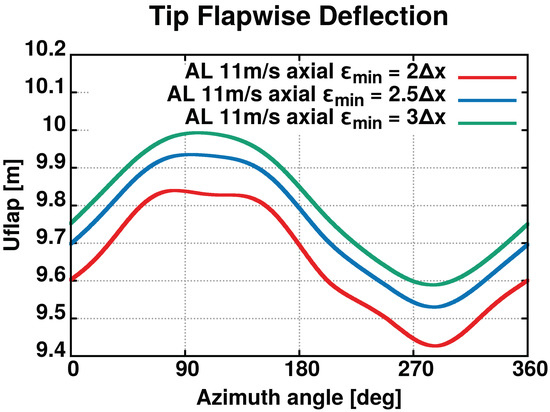
Figure 13.
Minimum value of investigation. Flapwise deflection in axial uniform free-stream flow at 11 m/s.
3.2. Helicopter Main Rotor Numerical Analysis
Following the preceding analysis, a helicopter MR is examined. The AL numerical parameters have been tested on case 851 which is a forward flight case at 12.3 m/s flight speed. The blades have been considered to be rigid in this study as well. A lot of conclusions extracted from the WT analysis have been used here without further investigation, namely:
- As depicted in Figure 14, a hexahedral grid set-up has been utilized;
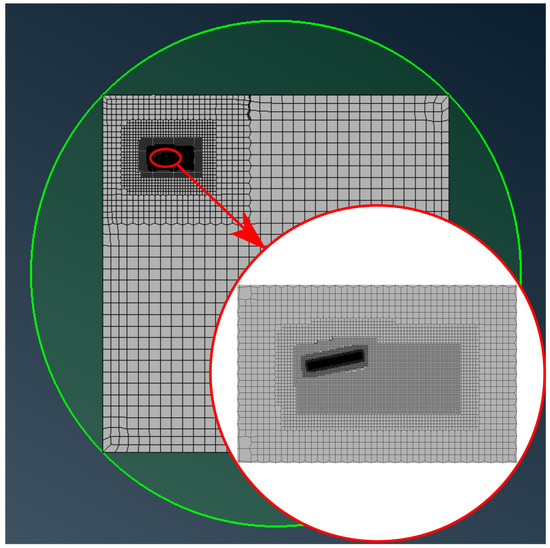 Figure 14. MR hexa grid setup.
Figure 14. MR hexa grid setup. - The ratio is used again for the near wake region;
- The Gaussian kernel is defined by the relationship (no further increase of was found to be necessary for MR aeroelastic simulations).
In Table 6, the rotor thrust predictions are listed with respect to different values of . Thrust was preferred as a metric over power in this case, due to its higher sensitivity to changes in the numerical parameters in helicopter cases. Ratio is considered to be the optimum compromise between accuracy and computational cost.

Table 6.
Variation of thrust [kN] with increasing the structured region characteristic length [m]. Reference thrust corresponds to minimum value .
In Table 7, the effect of is investigated. Due to constant airfoil along the blade span, reasonable accuracy in thrust prediction is obtained even with a lower number of control points. For MR aeroelastic simulations, a uniform distribution of control points with is used. Since does not penalize computational cost, the main criterion for choosing this parameter is the smooth radial distribution of the aerodynamic forces.

Table 7.
Variation of thrust [kN] with increasing blade grid size [m]. Reference thrust corresponds to minimum value .
The time-step is investigated in Table 8. In this case, the rule of thumb seems to be satisfactory. Overall blade grid and time resolution requirements are found to be relaxed in the helicopter case as higher values for and provided () and time independent loads.

Table 8.
Variation of thrust [kN] with increasing time-step [s]. Reference thrust corresponds to minimum value .
4. Results
In this section, results obtained by the investigated AL-based aeroelastic tool are compared against reference results obtained using lower fidelity aerodynamic tools or through wind tunnel measurements. Both WT and helicopter MR cases are assessed.
In WT cases, benchmark simulations are performed for the rotor of the conceptual DTU 10 MW reference wind turbine developed by DTU and employed as a reference turbine in a number of research projects (e.g., INNWIND.EU see [28]). Herein, the 5 tilt angle of the rotor, the 2.5 pre-cone angle of the blades, and the 3.332 m prebend at the blade tip have been properly considered. Simulations are performed for axial wind speed at 8 and 11 m/s magnitude. Yaw misalignment conditions are considered as well, where wind speed angle ranges from −30 to +30. The constant rotational speed and blade pitch angle are assumed for all wind speed values, as described in Table A1 in Appendix A. The rotation direction of the blades, the wind speed direction, and the definition of positive yaw angle are visualized in Figure A1. The airfoil data used for the blade element analysis on the control points of all the different aerodynamic models have been generated by DTU, using the in-house CFD solver EllipSys2D [56] in fully turbulent 2D simulations. AL results are compared to BEM and LL results.
For the helicopter rotor simulations, a scaled model of BO105 MR used in HeliNOVI wind tunnel tests is modeled. In this case, AL predictions are validated against LL simulation results and wind tunnel measurements of the HeliNOVI experiment [32]. Forward flight conditions are tested at low (12.3 m/s), medium (50.5 & 50.9 m/s), and high (69.6 & 69.9 m/s) flight speed conditions. Table A2, Table A3, Table A4 and Table A5 in Appendix A summarize the operational and trim data for these cases. Pitch and Roll attitudes are Euler angles defined in and respectively, whereas Pitch and Roll moments are defined in and (see Figure A2).
4.1. Wind Turbine Rotor Results
Table 9 lists the natural frequencies predictions of hGAST and other state-of-the-art aeroelastic tools (beam models) that were used in the Work Package 2 of the INNWIND.EU project for the DTU 10MW WT blades. The predicted frequencies are compared to FEM predictions obtained by NISA FEM code [57]. In Figure 15, the 3rd mode of the rotor is depicted, which corresponds to the 2nd flap mode of the blades. hGAST results are compared against the ones produced by NISA FEM code. More details can be found in [58].

Table 9.
DTU 10MW blades natural frequencies. Comparison between different structural models used in WP2 of the INNWIND.EU project.
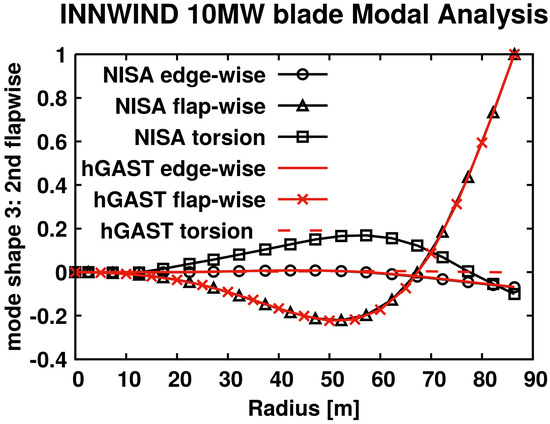
Figure 15.
Mode shape of 1st flapwise mode.
In the reference BEM module, the dynamic response of the wake due to time varying conditions is accounted for through an engineering dynamic inflow model [59]. The inflow model is actually a first order filter equation, which imposes a time delay on rotor induction and therefore on rotor loads when the thrust changes in time. It assumes the wake structure to be cylindrical and is tuned based on free-vortex-wake aerodynamic model results. In yaw misalignment cases, the induced velocity is corrected through the introduction of an extra term that models the asymmetric distribution of the induced velocities over the rotor disk due to wake skewness [59]. No tower shadow model is used in BEM computations. The azimuth angle is assumed to be zero when the blade points upwards (opposite to the ground). Blade loads and elastic deflections results are depicted as azimuthal variations and radial distributions along the blade span.
4.1.1. Axial Uniform Free-Stream Flow
Figure 16 depicts the out-of-plane bending moment () of the blade root and the out-of-plane deflection at the blade tip () for axial wind speed at 8 m/s. The variation is brought about by the 5° tilt angle of the rotor that shifts the maximum loading towards the azimuth position of 180°. Good agreement is observed in the mean values (maximum difference ). Furthermore, all the models predict a small amplitude of the variation (≤3.25% of the mean load). Nevertheless, BEM appears to have a phase difference of approximately 35, while the AL and LL results match perfectly with each other. Results for the predicted by the different models mean load, amplitude, and phase are tabulated in Table 10. The phase difference in BEM results can be attributed to disregarding the wake skewness effect induced by the tilt angle of the rotor in BEM model. The quality of agreement is similar between the different models in the out-of-plane deflection.
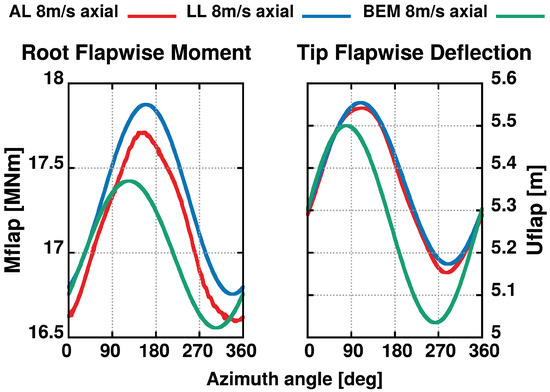
Figure 16.
Out-of-plane root bending moment and tip deflection at 8 m/s axial wind speed.

Table 10.
Out-of-plane bending moment of blade root at 8 m/s axial wind speed. Comparison between different aerodynamic models.
In Figure 17, the in-plane bending moment () of blade root and the in-plane deflection of blade tip () is shown for the same free-stream flow velocity. Nearly total agreement is achieved between the different aerodynamic models. In-plain loads and deflections are mainly driven by gravitational loads. Consequently, deviations between different aerodynamic analysis methodologies are not expected to have significant effect. This conclusion is valid in yaw misalignment cases as well. For this reason, the corresponding figures of and are omitted in the yaw misalignment section.
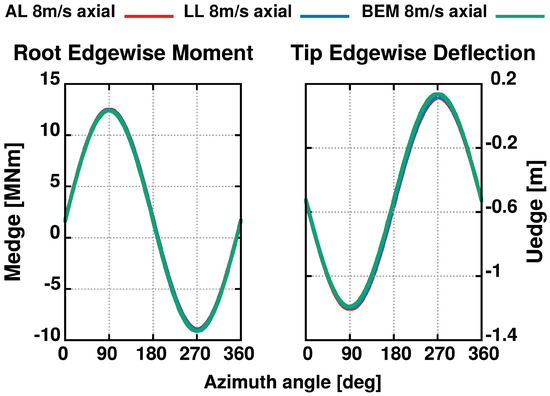
Figure 17.
In-plane root bending moment and tip deflection at 8 m/s axial wind speed.
As Figure 18 shows, the different aerodynamic models are in good agreement regarding the twisting moment () of blade root. Very small differences are predicted in the mean value of the tip torsion angle (about 0.02). The phase differences seen in and have vanished herein.

Figure 18.
Root twisting moment and tip torsion angle at 8 m/s axial wind speed.
Comparison of the Aerodynamic Models
It needs to be stressed that in LL and AL models, the blade “perceives” the wake-induced velocity in a different way compared to BEM. This is attributed to the detailed description of the 3D flow field by the Free Vortex Wake and the CFD methodologies respectively. Figure 19 verifies the correct effect of the tip correction model used in BEM [20], as the aerodynamic forces are effectively reduced close to the tip. As depicted in Figure 20 however, axial induction factor computed by BEM has a constant level difference and an increase towards the tip. This is the result of applying Prandtl’s tip correction formula directly on the thrust coefficient . In the root region, no corresponding correction model has been used to capture the effect of root vortices. For this reason, the axial induction factor there drops to zero.

Figure 19.
Normal force radial distribution at 8 m/s axial wind speed. Averaging over the final revolution of the simulation.
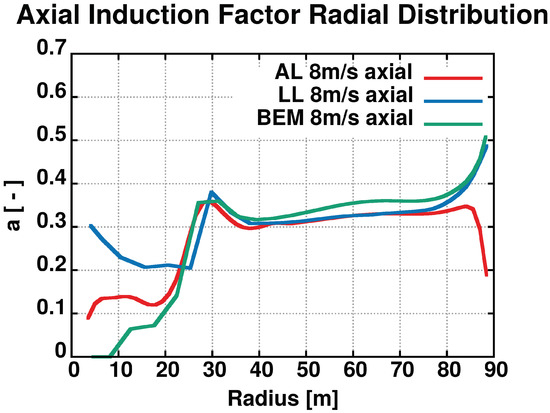
Figure 20.
Axial induction factor radial distribution at 8 m/s axial wind speed. Averaging over the final revolution of the simulation.
Back to the tip region, the same pattern holds for LL, but for a different reason. In this case, it is a result of the excessively strong vortices released from the tip. The exaggeration in tip vortices intensity, stems from the fact that the non-zero circulation of the last strip of the blade is followed by a zero circulation after that. In vortex methodologies, this sharp drop of circulation is directly translated to very high vorticity of the near wake filaments close to the tip. This is a fundamental difference between LL and AL, as the latter affects the flow through momentum exchange between fluid and blade. Another difference between the two models comes from the method of calculating the wake-induced velocity. In LL, the computation is performed directly on the control points of the strips through the application of Biot–Savart law. On the other hand, in this AL implementation the control point velocity is calculated based on a distance and volume weighted interpolation to the surrounding cells velocities using Radial Basis Functions [60]. For these reasons, the induced velocity predicted by the AL model tends to zero towards the tip along with blade normal force.
A comparison of the predicted circulation distribution along the span is shown in Figure 21. AL effectively predicts a circulation distribution that decreases sharply close to the tip. However, this is not depicted in the axial induction factor the same way with LL (Figure 20). It is therefore shown that in AL, the axial induction factor is not directly related to circulation radial variation as in the case of LL, or to an engineering correction model as in the case of BEM. The increased values of circulation in the root vicinity of LL can be justified by the potential nature of LL that changes circulation proportionally to the angle of attack. The higher circulation predicted by the LL model is related to the high values of the angle of attack at the root of the blade (see Figure 22) and the fact that the LL equation presumes a slope for the lift variation although this is not valid for the thick non-aerodynamic sections of the root region. Then an a posteriori correction on loads is performed to account for the reduced (or even zero) lift of these sections and the higher drag. In BEM and AL analysis, the calculation of the induction and the loads are in tight connection with the local airfoil polars. To sum up, the main differences between the models in prediction of the above mentioned flow parameters are focused on the blade tip and root regions.
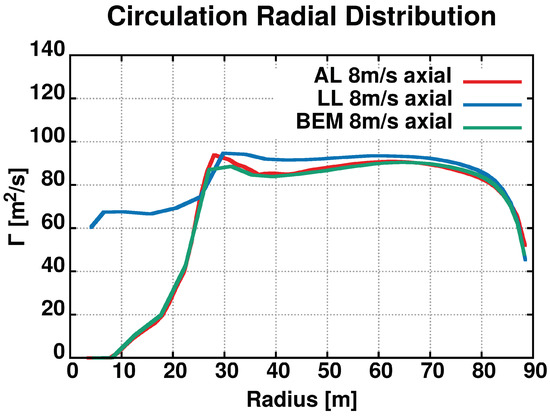
Figure 21.
Circulation radial distribution at 8 m/s axial wind speed. Averaging over the final revolution of the simulation.

Figure 22.
Angle of attack radial distribution at 8 m/s axial wind speed. Averaging over the final revolution of the simulation.
4.1.2. Yawed Uniform Free-Stream Flow
Figure 23 and Figure 24 depict the out-of-plane bending moment of the blade root at 8 and 11 m/s wind speed and for yaw angles of ±15 and ±30, respectively. A mean value difference is observed between BEM and the two higher fidelity models that increases with yaw angle (≈3.5% at ±15 and ≈8.5% at ±30). Mean wind speed has a smaller impact. Nevertheless, the amplitude of the variation changes similarly for all three methods. Moreover, a phase difference in the range 35–45 between BEM and the other two models exists in all cases. The corresponding deflections at the blade tip are depicted in Figure 25 and Figure 26, presenting qualitatively similar results with those moments.
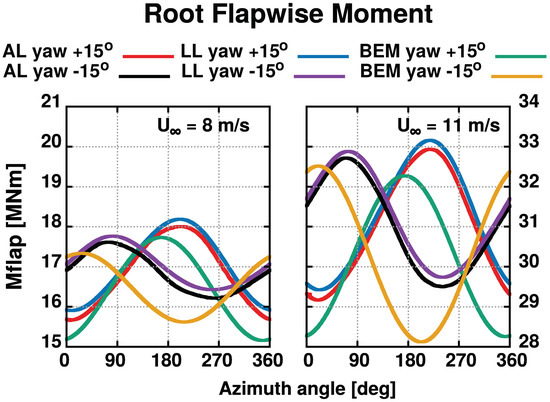
Figure 23.
Out-of-plane bending moment of blade root at 15 yawed wind speed at 8 and 11 m/s.
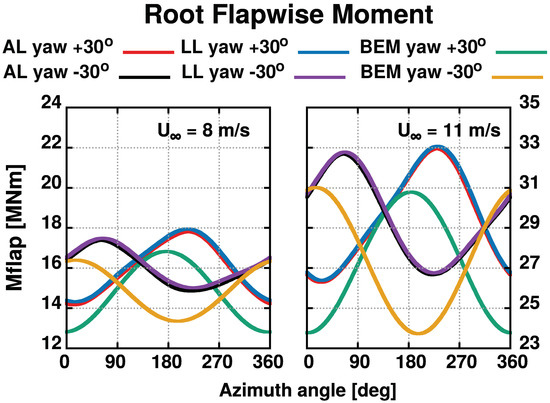
Figure 24.
Out-of-plane bending moment of blade root at 30 yawed wind speed at 8 and 11 m/s.
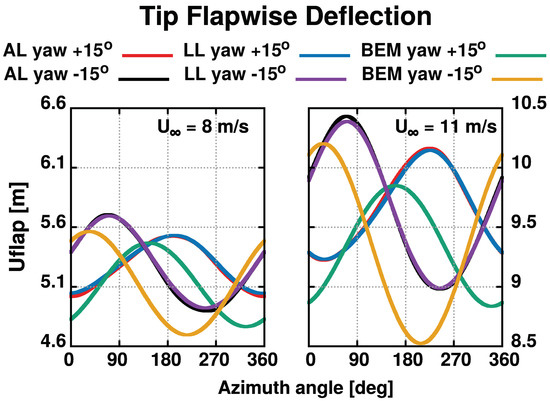
Figure 25.
Out-of-plane deflection of blade tip at 15 yawed wind speed at 8 and 11 m/s.
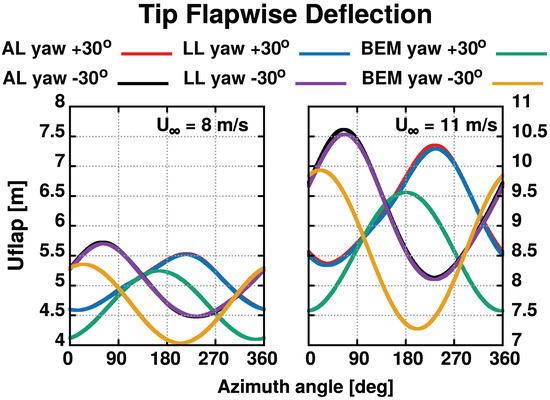
Figure 26.
Out-of-plane deflection of blade tip at 30 yawed wind speed at 8 and 11 m/s.
Figure 27 and Figure 28 show the twisting moment of the blade root at 8 and 11 m/s wind speed and for yaw angles of ±15 and ±30. The corresponding torsion angles at the blade tip are depicted in Figure 29 and Figure 30. Very good agreement is observed both for the mean values, as well as for the amplitudes of the variations. The phase differences of BEM encountered in the out-of-plane signals are not present, or at least are much less pronounced herein. The torsion angle is not only driven by the aerodynamic twisting moment but also by the out-of-plane bending loads as a result of very high flapwise deflection. This is also justified by the phase difference of the torsion angle signals, comparing positive and negative yaw angles, which agrees with the corresponding phase difference of the out-of-plane deflection and load signals.
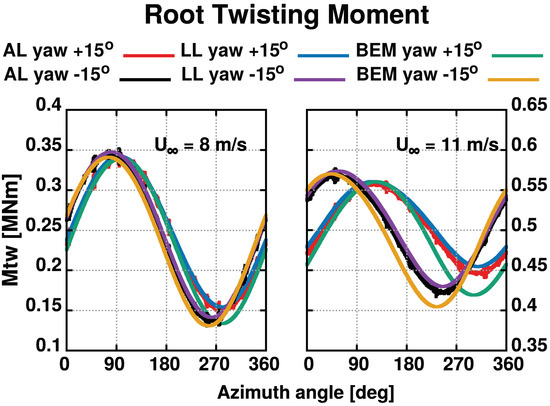
Figure 27.
Twisting moment of blade root at 15 yawed wind speed at 8 and 11 m/s.
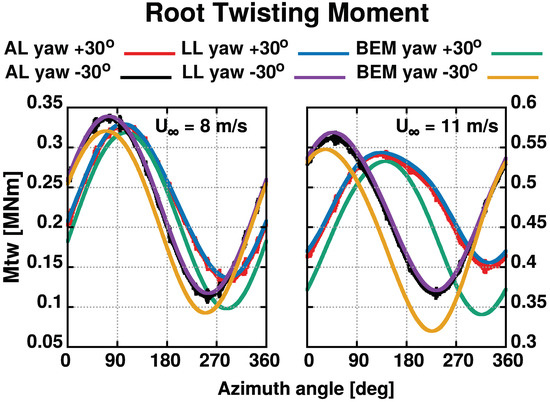
Figure 28.
Twisting moment of blade root at 30 yawed wind speed at 8 and 11 m/s.
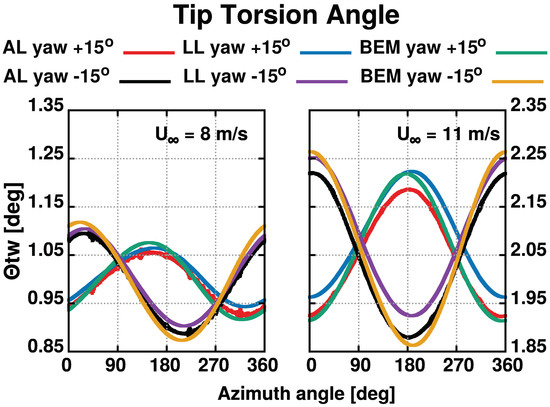
Figure 29.
Torsion angle of blade tip at 15 yawed wind speed at 8 and 11 m/s.
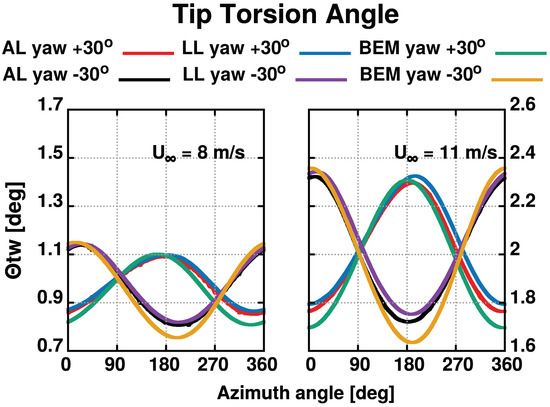
Figure 30.
Torsion angle of blade tip at 30 yawed wind speed at 8 and 11 m/s.
In summary, the main differences between the three models are concentrated in the out-of-plane moments (Figure 23 and Figure 24) and deflections (Figure 25 and Figure 26). A small difference ranging from to is observed in the mean value, alongside with a phase difference of about 35 to 45. This can be attributed to the differences encountered in the axial induction factor seen in Figure 31 and Figure 32. Clearly, AL and LL predict lower mean values compared to BEM, which explains the level difference of moments and deflections (lower induction results in higher inflow velocity and therefore in higher loads). This difference grows as the yaw angle increases. Furthermore, AL and LL predict higher variation amplitude of induction than BEM at all wind speeds and yaw angles. Moreover, a phase difference of about 20 to 45 is encountered, which is close to the one seen in the out-of-plane moments and deflections. The phase difference in loads and deformations is significant and needs deeper investigation. At positive yaw angles, both at a wind speed of 8 and 11 m/s, all aerodynamic models predict the maximum loading around the azimuth angle of 180. The reason for that is the increased relative velocity seen by the blade at this azimuth position, due to its clockwise rotation. In this position, the in-plane component of the wind is superimposed to the rotational speed of the blade. Apart from that, the effect of the wake skewness is important. It is the origin of the differences between the different aerodynamic models. The variation of the axial induction factor is much less pronounced in BEM results ( to of the mean value), which in turn leads to decreased phase shifting of the loads due to the wake skewness effect as compared to AL and LL models, where the amplitudes are higher ( to of the mean value). Minimum-induced velocity is predicted by all models close to the azimuth angle of 270, thus shifting maximum loads towards a greater azimuth position. The lower minimum-induced velocity predicted by AL and LL explains the 35 to 45 phase difference in the out-of-plane moments and deflections. Similar results are observed at negative yaw angles, but with a phase shift of 180 compared to positive values. The reason of the above differences is that in the AL and LL models, the wake induction is inherently included in the flow field and wake computations while in the BEM it is determined by an engineering yaw correction model.
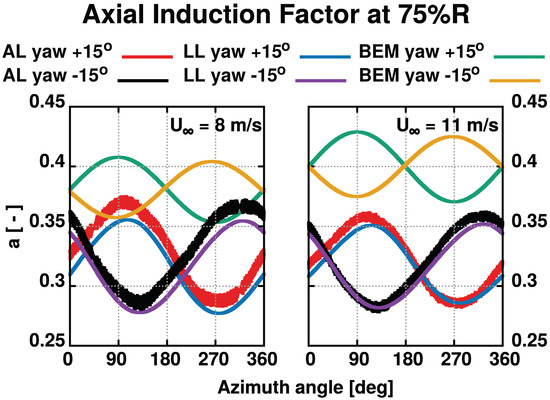
Figure 31.
Axial induction factor at of the blade at 15 yawed wind speed at 8 and 11 m/s.
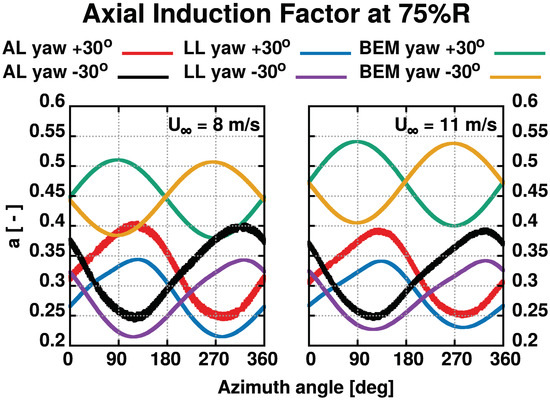
Figure 32.
Axial induction factor at of the blade at 30 yawed wind speed at 8 and 11 m/s.
4.2. Helicopter Main Rotor Results
Helicopter simulations correspond to the test matrix of the HeliNOVI wind tunnel experimental campaign [32]. Computations are performed in forward flight conditions at low (12.3 m/s), medium (50.5 & 50.9 m/s), and high (69.6 & 69.9 m/s) flight speed conditions. Operational details can be found in Table A2, Table A3, Table A4 and Table A5 in Appendix A.
AL results are compared against measurements and LL predictions. The comparisons concern azimuthal variations at one flight speed (the lowest) and harmonics of all flight speeds. A discrete Fourier analysis has been performed to blade loads of all the simulated cases. The results have been expressed in terms of amplitude and phase for the harmonic frequencies of the highest energy content. The corresponding mean values are presented in tabulated form.
At the present study, a global Rayleigh type structural damping [61] is applied which cannot reproduce correctly the exact modal damping of each mode. In Table 11, the damping ratio resulting for each mode of the BO105 MR blade is listed. In Figure 33, the predicted Campbell diagram (rotational speed range 0–1050 rpm) of the BO105 model blade is shown. In the modal analysis, the external loads (aerodynamic, gravitational) are neglected and structural damping is set to zero. For a fair comparison against measured data, the control angles (collective and cyclic pitch) have been trimmed based on a feedback control algorithm in order to match the predicted hub loads to the measured ones. Figure 34 compares the predicted by the two aerodynamic models MR pitch control angles against those used in the wind tunnel test campaign. Very good agreement is observed for all flight speeds in the collective and longitudinal pitch, whereas for lateral pitch there is an increasing deviation with the flight speed with a maximum difference of 2 at 70 m/s. Moreover, the rotor power requirement that is predicted by the two aerodynamic models is compared against the measured values in Figure 35. A maximum difference of about is noted in the high flight speed, which is attributed to the difference in the lateral cyclic pitch values and may as well indicate a disagreement in the predicted lead-lag moment.

Table 11.
BO105 MR blade damping ratio at 1050 rpm.
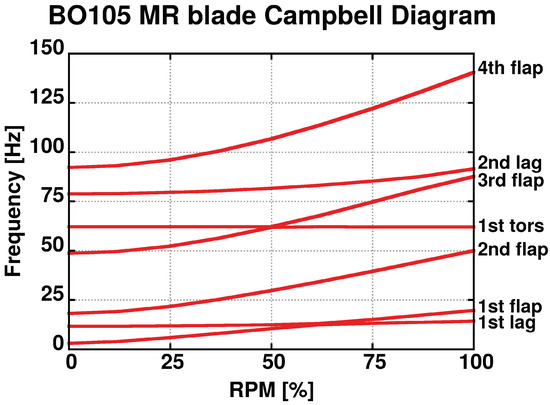
Figure 33.
Campbell diagram of BO105 MR.
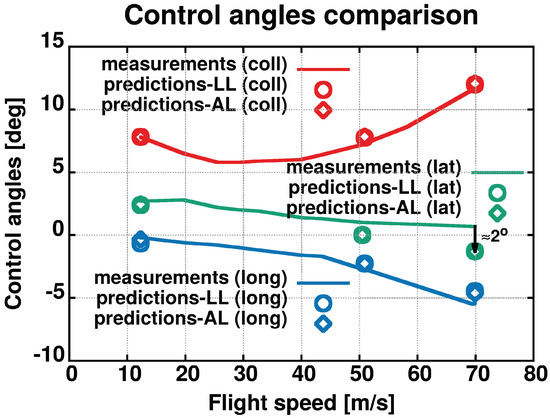
Figure 34.
Control angles comparison. Trimmed simulation values vs experimental measurements.
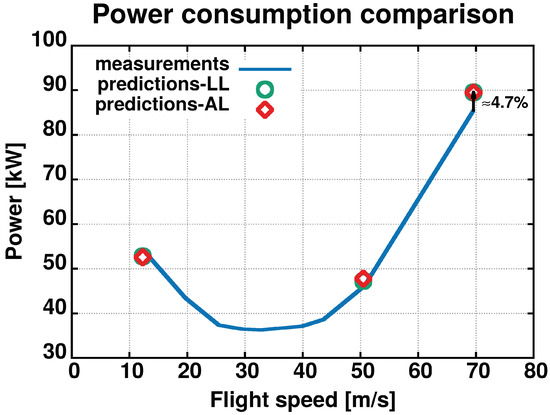
Figure 35.
Rotor power requirement comparison. Simulation predictions vs experimental measurements.
In the wind tunnel test, all blades were instrumented with load sensors, therefore blade loads for all blades were obtained. In the comparisons, predictions are compared to data from all available sensors. The missing data in some of the comparisons are due to broken or malfunctioning sensors.
4.2.1. Azimuthal Variation of Loads and Deflections at 12.3 m/s Flight Speed
In this low speed case, comparisons of predictions and measurements are made for blade loads and elastic displacements and the results are depicted as azimuthal variations. 0 azimuth corresponds to the blade pointing towards the tail boom, as shown in Figure A2 in Appendix A.
Notable differences both in the mean value, as well as in the amplitude of the variation are observed in the lead-lag bending moment (Figure 36). Load variations due to high frequency harmonics are well captured by the AL simulations. The LL model predicts a smoother variation of loads at higher frequencies, while the predicted signal is slightly shifted with respect to AL predictions and measurements. In the lead-lag deflections (Figure 37), predictions lead with respect to measurements. It is noted that positive deflection is in the lag direction. This is common in all three flight speeds and is mainly attributed to the technique used to measure blade deflections in the experimental campaign. The Stereo Pattern Recognition (SPR) that was used for the first time in the HART II and HeliNOVI projects, was repeatedly reported to show a consistent and unexplained 2–4 cm (≈1%) translational offset in the lag direction with respect to numerous and of varying fidelity computational method results [62,63]. In [32], the flexibility of the drive train system and the hub, which are regarded as infinitely stiff in our simulations, are considered as an extra source of discrepancies between measurements and predictions. The amplitude of the variation is well predicted by the computational models, however high frequency oscillations seen in measurements seem to be almost completely damped in both simulations.
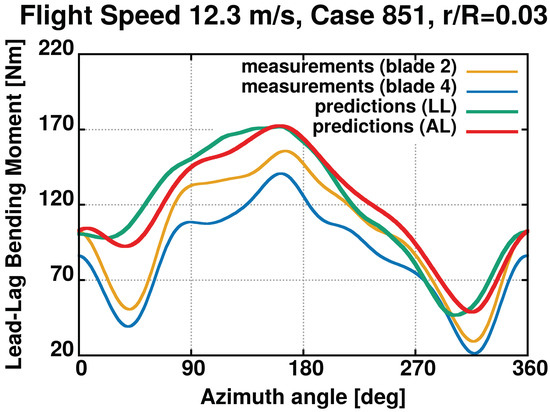
Figure 36.
Forward flight at 12.3 m/s, case 851. Lead-lag moment at .
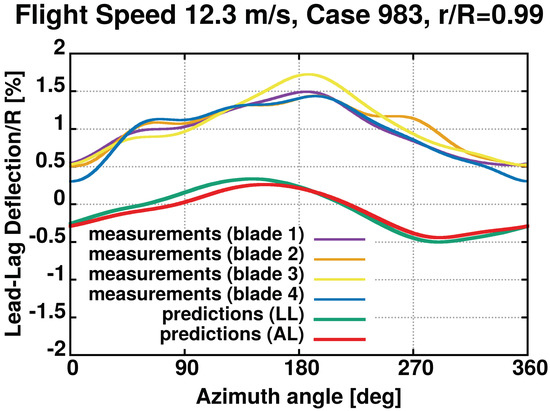
Figure 37.
Forward flight at 12.3 m/s, case 983. Lead-lag deflection at .
Good agreement is observed in the mean value of the flapwise bending moment (Figure 38). The amplitude is fairly predicted. High frequency variations seen in the measurements (mainly and ) are effectively reproduced by the simulations, with a small under-prediction of the respective amplitudes in LL results. Furthermore, a minor phase difference is seen in AL predictions which appears to be more pronounced in the LL predictions. The flapwise deflection amplitude (Figure 39) is clearly under-predicted by the two computations, which however agree well with each other. The high frequency variations seen in measurements are again effectively predicted.
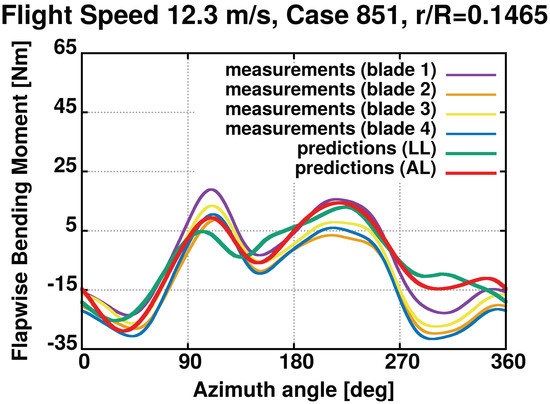
Figure 38.
Forward flight at 12.3 m/s, case 851. Flapwise moment at .
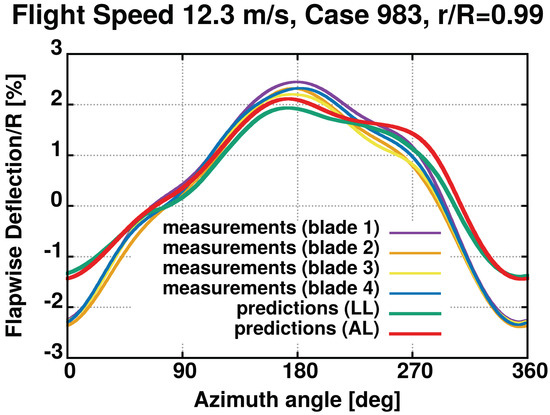
Figure 39.
Forward flight at 12.3 m/s, case 983. Flapwise deflection at .
Regarding twisting moment (Figure 40), a small difference is seen in the predicted mean value. A clear variation is seen in measurements, which is slightly under-predicted by the simulations. The mean value of the torsion angle is well predicted by the models (Figure 41), however with almost zero amplitude. Although the measured signal exhibits a dominant variation, a small component is also noted. The variation is well captured by the simulations, while a small phase shift is observed. The high frequency ripple in the LL simulation is related to higher harmonics or some higher frequency mode due to the BVI phenomena. This does not appear in the AL results due to the increased numerical diffusion of the AL analysis associated with the coarser far wake grid.
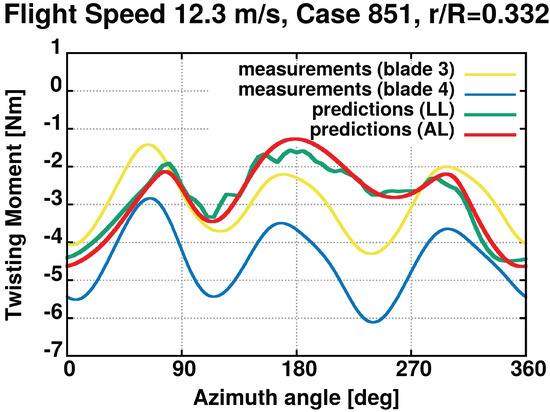
Figure 40.
Forward flight at 12.3 m/s, case 851. Twisting moment at .
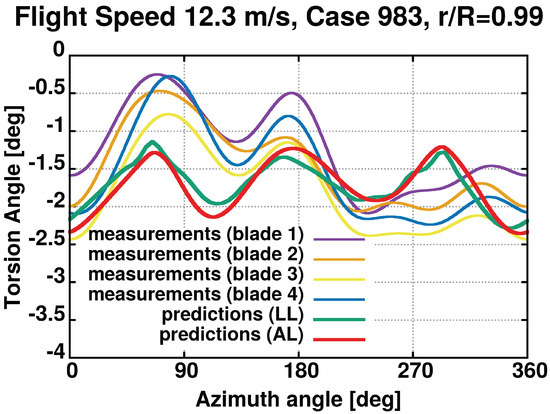
Figure 41.
Forward flight at 12.3 m/s, case 983. Torsion angle at .
4.2.2. Harmonic Analysis at Low, Medium, and High Flight Speed Cases
As stated in Section 4.2.1, computational simulations over-predict the mean value of the lead-lag moment at the low speed case. In Table 12, it is shown that this difference is about both for the LL and AL results. However, in the medium and high flight speed, the predicted mean values are within the scatter zone of the measurements of the different blades. The corresponding deflections in Table 13 show a ≈1% difference. This is consistent in all three flight speeds and is totally in line with the comments made in the previous section.

Table 12.
Mean values of blade structural loads.

Table 13.
Mean values of blade deflections.
The mean value of the flapwise bending moment is fairly predicted by the two aerodynamic models at and 50.5 m/s, whereas an over-estimation of about 1.5 Nm is observed at 69.6 m/s. This difference may seem large (≈60%), however it is smaller than the maximum difference of ≈2.5 Nm between different blades measurements. As far as the flapwise deflection is concerned, the computational results consistently predict slightly higher mean values at all flight speeds with a maximum difference of ≈0.4% at 69.9 m/s.
Finally, the simulations predict slightly smaller absolute mean values of the twisting moment at all the assessed cases. This difference increases with the flight speed up to at 69.6 m/s. On the other hand, very good agreement is achieved in the tip torsion angle, where a maximum difference of ≈0.15 is noted at 50.9 m/s.
Both in cases where the predicted values are close to the measured ones and in cases where discrepancies are noted, AL and LL seem to be in good agreement with each other.
Fourier analysis is performed on loads. Similar conclusions with respect to the harmonic content are expected to be drawn for deflections.
In Figure 42, the amplitude of the , , and variations are shown for the lead-lag bending moment. These are the highest excited harmonics of the lead lag moment. Both and amplitudes are fairly predicted by the computational tools, except from a difference in the amplitude at 50 m/s (≈15% of the mean value) and the amplitude at 70 m/s (≈6.5% of the mean value for the LL and ≈5% for the AL). The 4/rev harmonic exhibits much higher amplitudes as compared to predictions. This is attributed to a possible miss-match of the 2nd lead-lag mode of the wind tunnel model with respect to the design value. The corresponding frequency approaches in the test, which explains its high excitation. The 2nd lead-lag frequency is predicted at 91.58 Hz by the computational structural beam model, well apart from the (70 Hz) and close to the design value. This explains the low excitation of the in predictions. Better agreement is shown in the phase calculations (Figure 43) where a maximum phase shift is observed in the at the high speed case (70 for the LL results and 110 for the AL).
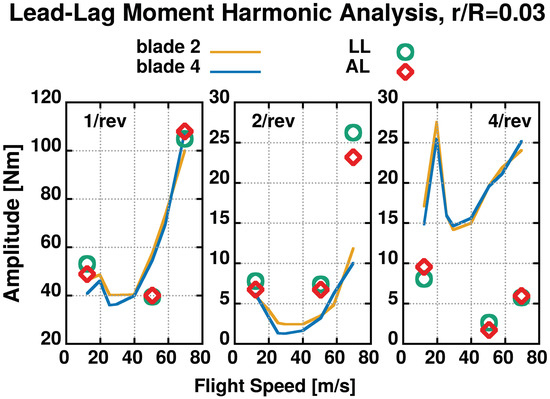
Figure 42.
Harmonic analysis of Lead-Lag bending moment. Amplitude of frequencies with the highest energy content.
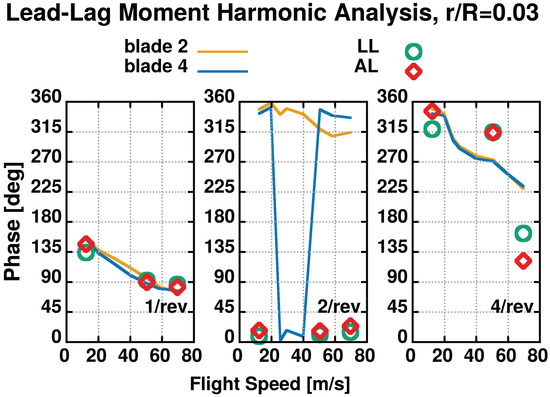
Figure 43.
Harmonic analysis of Lead-Lag bending moment. Phase of frequencies with the highest energy content.
The flapwise bending moment amplitudes (Figure 44) are generally predicted consistently in the simulations. However, in harmonic frequency, a maximum phase shift of 120 is seen at the medium flight speed in the LL results and 110 at the high flight speed in the AL results (see Figure 45).
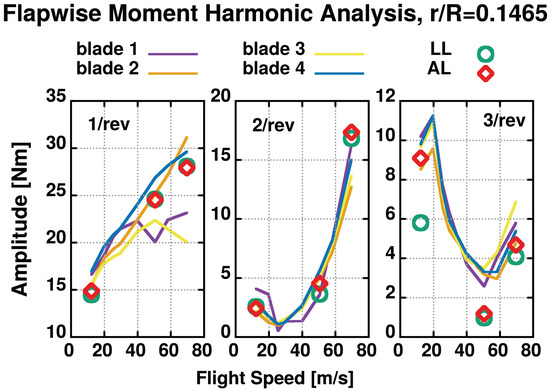
Figure 44.
Harmonic analysis of Flapwise bending moment. Amplitude of frequencies with the highest energy content.
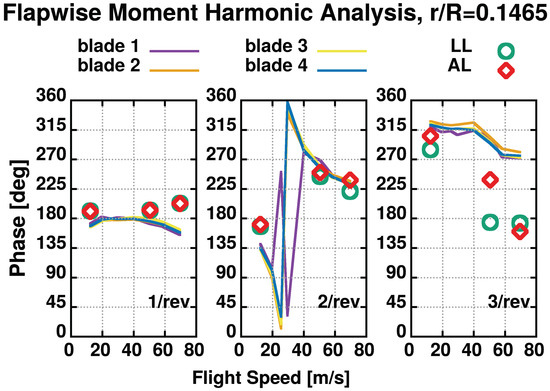
Figure 45.
Harmonic analysis of Flapwise bending moment. Phase of frequencies with the highest energy content.
Finally, the amplitudes of the different harmonic frequencies of the twisting moment are shown in Figure 46. A maximum difference of about of the mean value is observed at the amplitude of the low speed case for the LL results. The corresponding difference increases to for the AL case. Furthermore, the amplitude, that seem to be in the measurements of the low speed case, is slightly under-predicted by the simulations ( of the mean value in LL and in the AL results). The greatest phase difference (Figure 47) is observed in the phase of the low speed case, where a phase shift of 100 is noted in the LL results case and 110 in the AL case.
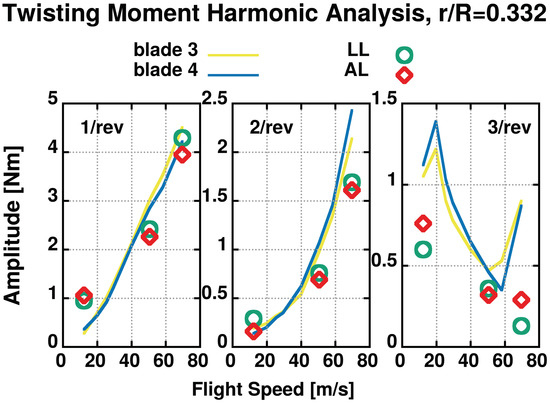
Figure 46.
Harmonic analysis of Twisting moment. Amplitude of frequencies with the highest energy content.
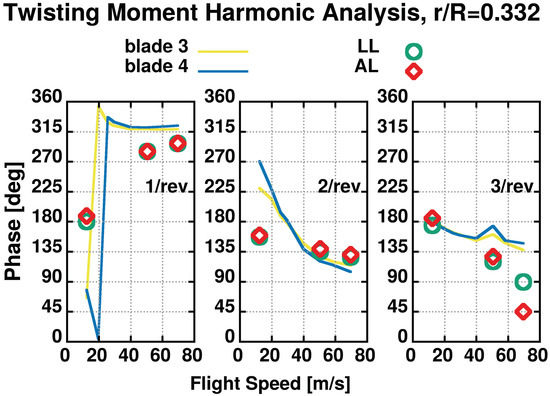
Figure 47.
Harmonic analysis of Twisting moment. Phase of frequencies with the highest energy content.
5. Conclusions
The paper assessed the accuracy of an AL aerodynamic model in aeroelastic simulations of WT and helicopter rotors. Comparisons are presented against a standard BEM model, a classical LL approach, and experimental data.
In the first part, a detailed investigation of the numerical parameters was performed. For WT simulations, it was found that a number of 90 cells in the rotor radius provided a grid independent solution, whilst a three times coarser discretization is suggested for the actuator lines. For the helicopter simulations, a number of 8 cells in the blade chord was sufficient. Time step was defined based on the grid resolution and tip velocity. The Gaussian kernel was chosen to vary with the chord length, but a lower bound of twice the grid spacing was set in order to avoid a too small kernel value at the blade tip.
In the WT case, comparisons between the AL module, a standard BEM model, and a LL approach were presented. At simple axial cases, good agreement was achieved by all three models in terms of loads and deflections prediction. Deviations occur between BEM and the other two models at yawed free-stream flow conditions. These differences become more pronounced as the yaw angle increased. However, excellent agreement between AL and LL was observed in all the examined cases. In contrast to LL, AL predicted wake-induced velocities that tended to a zero near blade tip. The same difference between these two models was observed in the circulation close to the blade root. For the Helicopter MR simulations, AL predictions were validated against LL simulation results and wind tunnel measurements of the HeliNOVI experiment. In general, predictions were close to the experimental measurements and when differences occur the two models results seemed to agree well with each other. Nevertheless, at low speed cases, in which wake-induced effects were stronger, the AL model achieved a better phase agreement with experimental data and greater aerodynamic damping.
Overall, AL results shared the same level of accuracy with the ones produced by the LL method. Although much more affordable than resolving the whole blade geometry, AL simulations remain at least 2 orders of magnitude more computationally demanding than LL. The main advantage of the AL method compared to LL, is that the rotor wake interaction with the boundary layer of the surrounding bodies (WT-Ground/Tower or MR-Ground/Fuselage) can be accounted for in detail within the CFD context. Moreover, vibrational blade loads induced by the flow separation around the fuselage may be accurately reproduced and studied.
Author Contributions
Conceptualization, V.A.R.; methodology, N.S., G.P., J.M.P. and V.A.R.; software, N.S., G.P., J.M.P. and V.A.R.; validation, N.S., G.P., J.M.P. and V.A.R.; formal analysis, N.S.; investigation, N.S.; resources, G.P., J.M.P. and V.A.R.; data curation, N.S.; writing—original draft preparation, N.S.; writing—review and editing, N.S. and V.A.R.; visualization, N.S.; supervision, V.A.R.; project administration, V.A.R.; funding acquisition, N.S. All authors have read and agreed to the published version of the manuscript.
Funding
The research work was supported by the Hellenic Foundation for Research and Innovation (HFRI) under the HFRI PhD Fellowship grant (Fellowship Number: 797).
Data Availability Statement
Data supporting reported results can be provided upon request to the corresponding authors.
Acknowledgments
NTUA computations were supported by computational time granted from the Greek Research & Technology Network (GRNET) in the National HPC facility-ARIS-under projects “ELASTURB” with ID pr005019_thin and “ELASTODYN” with ID pr010013_thin. The computational grids were generated using the ANSA CAE pre-processor of “BETA_CAE Systems S.A.”.
Conflicts of Interest
The authors declare no conflict of interest.
Abbreviations
The following abbreviations are used in this manuscript:
| WT | Wind Turbine |
| MR | Main Rotor |
| CFD | Computational Fluid Dynamics |
| BEM | Blade Element Momentum |
| LL | Lifting Line |
| AL | Actuator Line |
| URANS | Unsteady Reynolds Averaged Navier Stokes equations |
| D | Diameter |
| In-plane bending moment | |
| Out-of-plane bending moment | |
| Twisting moment | |
| In-plane deflection | |
| Out-of-plane deflection | |
| Megawatt |
Appendix A

Table A1.
INNWIND 10 MW operational data.
Table A1.
INNWIND 10 MW operational data.
| Wind Speed (m/s) | Rotational Speed (rpm) | Pitch Anlge (°) |
|---|---|---|
| 8 | 0 | |
| 11 | 0 |
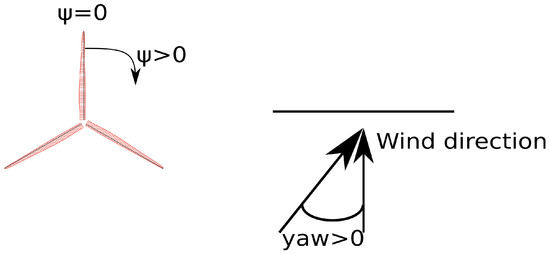
Figure A1.
Horizontal axis wind turbine visualization.

Table A2.
BO105 free-stream flow data.
Table A2.
BO105 free-stream flow data.
| Case | Flight Speed (m/s) | Air density (kg/m) | Temperature (°C) |
|---|---|---|---|
| 851 | |||
| 844 | |||
| 847 | |||
| 983 | |||
| 907 | |||
| 918 |

Table A3.
BO105 Helicopter attitudes.
Table A3.
BO105 Helicopter attitudes.
| Case | Side Slip (°) | Pitch Attitude (°) | Roll Attitude (°) |
|---|---|---|---|
| 851 | |||
| 844 | |||
| 847 | |||
| 983 | |||
| 907 | |||
| 918 |

Table A4.
BO105 rotational speed and control angles.
Table A4.
BO105 rotational speed and control angles.
| Case | Rotational Speed (rpm) | Collective Pitch (°) | Lateral Pitch (°) | Longitudinal Pitch (°) |
|---|---|---|---|---|
| 851 | 1047 | |||
| 844 | 1050 | |||
| 847 | 1050 | |||
| 983 | 1051 | |||
| 907 | 1051 | |||
| 918 | 1051 |

Table A5.
BO105 hub loads.
Table A5.
BO105 hub loads.
| Case | Thrust (N) | Pitch Moment (Nm) | Roll Moment (Nm) |
|---|---|---|---|
| 851 | |||
| 844 | |||
| 847 | |||
| 983 | |||
| 907 | |||
| 918 |

Figure A2.
BO105 Fuselage (F) and Rotor disk (R) coordinate systems.
References
- Sørensen, J.N.; Shen, W.Z. Numerical modeling of wind turbine wakes. J. Fluids Eng. Trans. ASME 2002, 124, 393–399. [Google Scholar] [CrossRef]
- Ivanell, S.; Sørensen, J.N.; Mikkelsen, R.; Henningson, D. Analysis of numerically generated wake structures. Wind Energy 2009, 12, 63–80. [Google Scholar] [CrossRef]
- Troldborg, N.; Sorensen, J.N.; Mikkelsen, R. Numerical simulations of wake characteristics of a wind turbine in uniform inflow. Wind Energy 2010, 13, 86–99. [Google Scholar] [CrossRef]
- Bühler, M.; Weihing, P.; Klein, L.; Lutz, T.; Kramer, E. Actuator Line Method Simulations for the Analysis of Wind Turbine Wakes Acting on Helicopters. J. Phys. Conf. Ser. 2018, 1037, 062004. [Google Scholar] [CrossRef] [Green Version]
- Delorme, Y.; Stanly, R.; Frankel, S.H.; Greenblatt, D. Application of Actuator Line Model for Large Eddy Simulation of Rotor Noise Control. Aerosp. Sci. Technol. 2021, 108, 106405. [Google Scholar] [CrossRef]
- Merabet, R.; Laurendeau, E. Actuator Line Method for Helicopter Rotors Computations in Various Flight Conditions. 2021. Available online: https://www.casi.ca/resources/Documents/AERO/2021/Full%20Papers/Actuator%20Line%20Method%20for%20Helicopter%20Rotors%20Computations%20in.pdf (accessed on 8 October 2021).
- Troldborg, N.; Sørensen, J.N.; Mikkelsen, R. Actuator line simulation of wake of wind turbine operating in turbulent inflow. J. Phys. Conf. Ser. 2007, 75, 12063. [Google Scholar] [CrossRef]
- Sorensen, J.N.; Mikkelsen, R.F.; Henningson, D.S.; Ivanell, S.; Sarmast, S.; Andersen, S.J. Simulation of wind turbine wakes using the actuator line technique. Philos. Trans. R. Soc. A Math. Phys. Eng. Sci. 2015, 373, 20140071. [Google Scholar] [CrossRef] [PubMed] [Green Version]
- Andronikos, T.; Papadakis, G.; Riziotis, V.A.; Prospathopoulos, J.M.; Voutsinas, S.G. Validation of a cost effective method for the rotor-obstacle interaction. Aerosp. Sci. Technol. 2021, 113, 106698. [Google Scholar] [CrossRef]
- Madsen, H.A.; Riziotis, V.; Zahle, F.; Larsen, T.J.; Politis, E.; Hansen, M.O.L.; Snel, H.; Grasso, F. BEM modeling of inflow with shear in comparison with advanced model results. Sci. Mak. Torque Wind. 2010, 1–12. Available online: https://orbit.dtu.dk/en/publications/bem-modeling-of-inflow-with-shear-in-comparison-with-advanced-mod (accessed on 8 October 2021).
- Andronikos, T.; Papadakis, G.; Riziotis, V.; Voutsinas, S. Revising of the Near Ground Helicopter Hover: The Effect of Ground Boundary Layer Development. Appl. Sci. 2021, 11, 9935. [Google Scholar] [CrossRef]
- Tossas, L.A.M.; Leonardi, S. Wind Turbine Modeling for Computational Fluid Dynamics December 2010; National Renewable Energy Lab.(NREL): Golden, CO, USA, 2013; p. 57. [Google Scholar]
- Shives, M.; Crawford, C. Mesh and load distribution requirements for actuator line CFD simulations. Wind Energy 2012, 16, 1183–1196. [Google Scholar] [CrossRef]
- Jha, P.K.; Churchfield, M.J.; Moriarty, P.J.; Schmitz, S. Guidelines for volume force distributions within actuator line modeling of wind turbines on large-eddy simulation-type grids. J. Sol. Energy Eng. Trans. ASME 2014, 136, 1–11. [Google Scholar] [CrossRef]
- Churchfield, M.J.; Schreck, S.; Martínez-Tossas, L.A.; Meneveau, C.; Spalart, P.R. An advanced actuator line method for wind energy applications and beyond. In Proceedings of the 35th Wind Energy Symposium, Grapevine, TX, USA, 9–13 January 2017; pp. 1–20. [Google Scholar] [CrossRef] [Green Version]
- Jha, P.K.; Schmitz, S. Actuator curve embedding—An advanced actuator line model. J. Fluid Mech. 2018, 834, 1–11. [Google Scholar] [CrossRef]
- Shen, W.Z.; Sørensen, J.N.; Mikkelsen, R. Tip loss correction for actuator/Navier-Stokes computations. J. Sol. Energy Eng. Trans. ASME 2005, 127, 209–213. [Google Scholar] [CrossRef]
- Dağ, K.O.; Sørensen, J.N. A new tip correction for actuator line computations. Wind Energy 2020, 23, 148–160. [Google Scholar] [CrossRef]
- Prandtl, L. Applications of Modern Hydrodynamics to Aeronautics; US Government Printing Office: Washington, DC, USA, 1921. [Google Scholar]
- Glauert, H. Airplane Propellers. In Aerodynamic Theory; Durand, W.F., Ed.; Springer: Berlin/Heidelberg, Germanty, 1935; pp. 169–360. [Google Scholar] [CrossRef]
- Motta-Mena, J.; Jha, P.; Campbell, R.L.; Schmitz, S.; Brasseur, J. Wind turbine fluid-structure interaction using an actuator line solver and a finite element solver in a tightly-coupled implementation. In Proceedings of the 32nd ASME Wind Energy Symposium, Houston, TX, USA, 13–17 January 2014; p. 0717. [Google Scholar] [CrossRef]
- Jha, P.K.; Churchfield, M.J.; Moriarty, P.J.; Schmitz, S. Accuracy of state-of-the-art actuator-line modeling for wind turbine wakes. In Proceedings of the 51st AIAA Aerospace Sciences Meeting including the New Horizons Forum and Aerospace Exposition 2013, Grapevine, TX, USA, 7–10 January 2013; p. 608. [Google Scholar] [CrossRef]
- Jonkman, J.; Butterfield, S.; Musial, W.; Scott, G. Definition of a 5-MW Reference Wind Turbine for Offshore System Development; Technical Report; National Renewable Energy Lab. (NREL): Golden, CO, USA, 2009. [Google Scholar]
- Meng, H.; Lien, F.S.; Li, L. Elastic actuator line modelling for wake-induced fatigue analysis of horizontal axis wind turbine blade. Renew. Energy 2018, 116, 423–437. [Google Scholar] [CrossRef]
- Jonkman, J.M.; Buhl, M.L., Jr. FAST User’s Guide; National Renewable Energy Laboratory: Golden, CO, USA, 2005. [Google Scholar]
- Yu, Z.; Hu, Z.; Zheng, X.; Ma, Q.; Hao, H. Aeroelastic performance analysis of wind turbine in the wake with a new elastic actuator line model. Water 2020, 12, 1233. [Google Scholar] [CrossRef]
- Hodgson, E.L.; Andersen, S.J.; Troldborg, N.; Forsting, A.M.; Mikkelsen, R.F.; Sørensen, J.N. A quantitative comparison of aeroelastic computations using flex5 and actuator methods in les. J. Phys. Conf. Ser. 2021, 1934, 012014. [Google Scholar] [CrossRef]
- Bak, C.; Zahle, F.; Bitsche, R.; Kim, T.; Yde, A.; Henriksen, L.C.; Hansen, M.H.; Blasques, J.P.A.A.; Gaunaa, M.; Natarajan, A. The DTU 10-MW Reference Wind Turbine. 2013. Available online: https://backend.orbit.dtu.dk/ws/portalfiles/portal/55645274/The_DTU_10MW_Reference_Turbine_Christian_Bak.pdf (accessed on 8 October 2021).
- Wang, J.; Foley, S.; Nanos, E.; Yu, T.; Campagnolo, F.; Bottasso, C.L.; Zanotti, A.; Croce, A. Numerical and experimental study of wake redirection techniques in a boundary layer wind tunnel. J. Phys. Conf. Ser. 2017, 854, 012048. [Google Scholar] [CrossRef]
- Nanos, E.M.; Letizia, S.; Clemente, D.J.B.; Wang, C.; Rotea, M.; Iungo, V.I.; Bottasso, C.L. Vertical wake deflection for offshore floating wind turbines by differential ballast control. J. Phys. Conf. Ser. 2020, 1618, 022047. [Google Scholar] [CrossRef]
- Voutsinas, S.G. Vortex methods in aeronautics: How to make things work. Int. J. Comput. Fluid Dyn. 2006, 20, 3–18. [Google Scholar] [CrossRef]
- Langer, H.J.; Dieterich, O.; Oerlemans, S.; Schneider, O.; Wall, B.V.; Yin, J. The EU HeliNOVI project -wind tunnel investigations for noise and vibration reduction. In Proceedings of the 31st European Rotorcraft Forum, Florence, Italy, 13–15 September 2005. [Google Scholar]
- Papadakis, G. Development of a Hybrid Compressible Vortex Particle Method and Application to External Problems Including Helicopter Flows. Ph.D. Thesis, National Technical University of Athens (NTUA), Athens, Greece, 2014. [Google Scholar]
- Papadakis, G.; Voutsinas, S.G. In view of accelerating CFD simulations through coupling with vortex particle approximations. J. Phys. Conf. Ser. 2014, 524, 012126. [Google Scholar] [CrossRef]
- Papadakis, G.; Voutsinas, S.G. A strongly coupled Eulerian Lagrangian method verified in 2D external compressible flows. Comput. Fluids 2019, 195, 104325. [Google Scholar] [CrossRef]
- Karypis, G.; Kumar, V. METIS: A Software Package for Partitioning Unstructured Graphs, Partitioning Meshes, and Computing Fill-Reducing Orderings of Sparse Matrices; University of Minnesota Twin Cities: Minneapolis, MN, USA, 1997; Volume 4. [Google Scholar]
- Roe, P.L. Characteristic-Based Schemes for the Euler Equations. Annu. Rev. Fluid Mech. 1986, 1, 337–365. [Google Scholar] [CrossRef]
- Venkatakrishnan, V. On the accuracy of limiters and convergence to steady state solutions. In Proceedings of the 31st Aerospace Sciences Meeting, Reno, NV, USA, 11–14 January 1993; p. 880. [Google Scholar]
- Spalart, P.; Allmaras, S. A one-equation turbulence model for aerodynamic flows. In Proceedings of the 30th Aerospace Sciences Meeting and Exhibit, Reno, NV, USA, 6–9 January 1992; p. 439. [Google Scholar]
- Menter, F.R. Two-equation eddy-viscosity turbulence models for engineering applications. AIAA J. 1994, 32, 1598–1605. [Google Scholar] [CrossRef] [Green Version]
- Langtry, R.B.; Menter, F.; Likki, S.; Suzen, Y.; Huang, P.; Völker, S. A Correlation-Based Transition Model Using Local Variables—Part II: Test Cases and Industrial Applications. J. Turbomach. 2006, 128, 423–434. [Google Scholar] [CrossRef]
- Shur, M.L.; Spalart, P.R.; Strelets, M.K.; Travin, A.K. A hybrid RANS-LES approach with delayed-DES and wall-modelled LES capabilities. Int. J. Heat Fluid Flow 2008, 29, 1638–1649. [Google Scholar] [CrossRef]
- Biedron, R.; Thomas, J. Recent Enhancements to the FUN3D Flow Solver for Moving-Mesh Applications. In Proceedings of the 47th AIAA Aerospace Sciences Meeting Including The New Horizons Forum and Aerospace Exposition, Orlando, FL, USA, 5–8 January 2010; p. 1360. [Google Scholar]
- Vatsa, V.N.; Carpenter, M.H.; Lockard, D.P. Re-evaluation of an optimized second order backward difference (BDF2OPT) scheme for unsteady flow applications. In Proceedings of the 48th AIAA Aerospace Sciences Meeting Including the New Horizons Forum and Aerospace Exposition, Orlando, FL, USA, 4–7 January 2010. [Google Scholar] [CrossRef] [Green Version]
- Petot, D. Dynamic Stall Modelling Using Differential Equations. La Rech. Aerosp. (Engl. Ed.) 1989, 5, 59–72. [Google Scholar]
- Van Truong, K. Modeling aerodynamics, including dynamic stall, for comprehensive analysis of helicopter rotors. Aerospace 2017, 4, 21. [Google Scholar] [CrossRef] [Green Version]
- Wang, K.; Riziotis, V.A.; Voutsinas, S.G. Aeroelastic stability of idling wind turbines. Wind Energy Sci. 2017, 2, 415–437. [Google Scholar] [CrossRef] [Green Version]
- Riziotis, V.A.; Voutsinas, S.G. GAST: A general aerodynamic and structural prediction tool for wind turbines. In Ewec-Conference; Bookshop for Scientific Publications: Dubai, United Arab Emirates, 1997; p. 448. Available online: https://www.tib.eu/en/search/id/BLCP:CN027428110/GAST-A-general-aerodynamic-and-structural-prediction?cHash=a3bf6aadfee697e2f68fb530cb14c781 (accessed on 8 October 2021).
- Riziotis, V.A.; Voutsinas, S.G.; Politis, E.S.; Chaviaropoulos, P.K.; Hansen, A.M.; Madsen, H.A.; Rasmussen, F. Identification of structural non-linearities due to large deflections on a 5MW wind turbine blade. Eur. Wind Energy Conf. Exhib. 2008 2008, 1, 102–112. Available online: https://www.researchgate.net/publication/279531128_Identification_of_structural_non-linearities_due_to_large_deflections_on_a_5MW_wind_turbine_blade (accessed on 8 October 2021).
- Riziotis, V.A.; Voutsinas, S.G.; Manolas, D.I.; Politis, E.S.; Chaviaropoulos, P.K. Aeroelastic analysis of pre-curved rotor blades. Eur. Wind Energy Conf. Exhib. 2010, 2, 1173–1202. Available online: https://www.researchgate.net/profile/V-Riziotis/publication/268417271_Aeroelastic_Analysis_of_Pre-Curved_Rotor_Blades/links/5489598a0cf268d28f0920aa/Aeroelastic-Analysis-of-Pre-Curved-Rotor-Blades.pdf (accessed on 8 October 2021).
- Manolas, D.I.; Riziotis, V.A.; Voutsinas, S.G. Assessing the Importance of Geometric Nonlinear Effects in the Prediction of Wind Turbine Blade Loads. J. Comput. Nonlinear Dyn. 2015, 10, 041008. [Google Scholar] [CrossRef]
- Bagherpour, T.; Li, X.; Manolas, D.; Riziotis, V. Modeling of material bend-twist coupling on wind turbine blades. Compos. Struct. 2018, 193, 237–246. [Google Scholar] [CrossRef]
- Bauchau, O.A.; Bottasso, C.L.; Nikishkov, Y.G. Modeling rotorcraft dynamics with finite element multibody procedures. Math. Comput. Model. 2001, 33, 1113–1137. [Google Scholar] [CrossRef]
- Bathe, K.J. Finite Element Procedures. 2006. Available online: https://books.google.co.kr/books?hl=zh-CN&lr=&id=rWvefGICfO8C&oi=fnd&pg=PR13&dq=Bathe,+K.J.+Finite+Element+Procedures&ots=gHFICSnsD2&sig=4fSXpBDU92S97s5BfJlg4ykA81U#v=onepage&q=Bathe%2C%20K.J.%20Finite%20Element%20Procedures&f=false (accessed on 8 October 2021).
- Spyropoulos, N.; Prospathopoulos, J.; Manolas, D.; Papadakis, G.; Riziotis, V.A. Development of a fluid structure interaction tool based on an actuator line model. J. Phys. Conf. Ser. 2020, 1618, 052072. [Google Scholar] [CrossRef]
- Bertagnolio, F.; Sørensen, N.; Johansen, J. Status for the Two-Dimensional Navier-Stokes Solver EllipSys2D. 2001; Volume 1282. Available online: https://www.osti.gov/etdeweb/biblio/20195546 (accessed on 8 October 2021).
- Fancev, T.; Grgic, D.; Saban, I. NISA FEM Support in Seismic Qualification of Small Class 1E Electric Motors. 1996. Available online: https://www.osti.gov/etdeweb/biblio/656228 (accessed on 8 October 2021).
- Manolas, D.I.; Pirrung, G.R.; Croce, A.; Roura, M.; Riziotis, V.A.; Madsen, H.A.; Pizarro, C.; Voutsinas, S.G.; Rasmussen, F. Cross comparison of aeroelastic state-of-the-art design tools on a 10 MW scale wind turbine. In Proceedings of the European Wind Energy Association Annual Conference and Exhibition 2015, EWEA 2015-Scientific Proceedings, Paris, France, 17–20 November 2015. [Google Scholar]
- Voutsinas, S.G.; Riziotis, V.A.; Chaviaropoulos, P. Non-linear aerodynamics and fatigue loading on wind turbines operating at extreme sites. In Proceedings of the 35th Aerospace Sciences Meeting and Exhibit, Reno, NV, USA, 6–9 January 1997; p. 935. [Google Scholar] [CrossRef]
- Zhu, S. Compactly Supported Radial Basis Functions: How and Why? 2012, pp. 24–29. Available online: https://ora.ox.ac.uk/objects/uuid:698c1230-9719-455f-a486-80eb9ed80163 (accessed on 8 October 2021).
- Clough, R.W.; Penzien, J. Dynamics of Structures McGraw-Hill. 1993. Available online: https://www.chaocompute.com/wp-content/uploads/2020/07/Dynamics-of-Structures-Clough-Penzien.pdf (accessed on 8 October 2021).
- Van der Wall, B.G.; Lim, J.W.; Smith, M.J.; Jung, S.N.; Bailly, J.; Baeder, J.D.; Douglas Boyd, D. The HART II international workshop: An assessment of the state-of-the-art in comprehensive code prediction. CEAS Aeronaut. J. 2014, 4, 223–252. [Google Scholar] [CrossRef]
- Smith, M.J.; Lim, J.W.; van der Wall, B.G.; Baeder, J.D.; Biedron, R.T.; Boyd, D.D.; Jayaraman, B.; Jung, S.N.; Min, B.Y. The HART II international workshop: An assessment of the state of the art in CFD/CSD prediction. CEAS Aeronaut. J. 2013, 4, 345–372. [Google Scholar] [CrossRef]
Publisher’s Note: MDPI stays neutral with regard to jurisdictional claims in published maps and institutional affiliations. |
© 2021 by the authors. Licensee MDPI, Basel, Switzerland. This article is an open access article distributed under the terms and conditions of the Creative Commons Attribution (CC BY) license (https://creativecommons.org/licenses/by/4.0/).